

¿Qué es un Joint Business Planning?
Alex ramirez.
- Apr 29, 2019
- Noticias Diarias , Retail , Retail Experience , Retail Marketing

Vivimos en un mundo cada vez más globalizado e interconectado. Esto no sólo es válido para las personas, sino también para los retailers , sus proveedores y las marcas de los productos que ofrecen. Por este motivo, ya no es suficiente que realicen sus esfuerzos de manera separada para llegar al cliente , sino que todas las partes involucradas en un proceso como el de venta tendrán que trabajar en conjunto, con la finalidad de aproximarse de una manera más efectiva con su público meta. Esto está asociado al concepto conocido como Joint Business Planning . ¿Qué significa específicamente este concepto? En las siguientes líneas hablaremos sobre él.
EL Joint Business Planning, el cual se abrevia por sus siglas como JBP, se puede comprender como un plan conjunto de negocios , por medio del cual retailers y proveedores establecen objetivos, estrategias y objetivos en común, para los cuales trabajarán de manera coordinada.
Dicho en otras palabras, el Joint Business Planning es la serie de pasos, herramientas y técnicas de las que se apoyarán los proveedores y los retailers con la finalidad de que el negocio de las partes involucradas crezca de manera sustentable y, sobre todo, de manera rentable.
Uno de los principales beneficios con los que cuenta el Joint Business Planning en el caso particular del retail es que tanto el distribuidor como el proveedor pueden trabajar para evitar de manera conjunta el quiebre del stock, por medio de un proceso de surtido mucho más eficiente.
Por medio de este plan integral entre las partes participantes en un negocio se buscará el modo de maximizar las ventas que se registren, sin tener que recurrir a modificaciones innecesarias en los precios de los productos, pero, al mismo tiempo, optimizando las ganancias que se consiguen, por medio del trabajo conjunto entre el retailer en cuestión y el proovedor.
Únete a más de 25 mil lectores
Regístrate a nuestro newsletter en la siguiente forma y recibe a primera hora las noticias más importantes de marketing de consumo, BTL y retail tu correo.

Star Wars, un tópico recurrente (y exitoso) entre las marcas

El miedo vende

Amazon Cash y Mercado Pago, dos opciones de pago para clientes no bancarizados
Nine west reunió 500 confesiones.

3 errores de BTL para no aprovechar el Mundial en su negocio
Contenido premium.

De experimento casero a una marca transnacional refrescante

“El viaje es por ti”, 10 años de Hyundai en México

Marketing 360: nuevos productos, mayor alcance

El ABC del desarrollo de producto

Giovanna Mureddu, de estudiante inquieta a triunfadora empresaria
Artículos relacionados

Fashion Networking Hall
Conoce los puntos de vista de expertos en moda sobre tendencias en marketing de esta categoría, tanto en piso de venta como eCommerce.

Experiencia de compra interactiva a través de una Pop Up Store
Su tiempo limitado, colecciones exclusivas y diseño son algunos elementos que impulsan el éxito de estas tiendas.

Walmart abre nueva tienda al sur de México
Con el objetivo de llegar a más lugares, Walmart abrió una nueva tienda física al sur de México. Conoce su ubicación, tamaño y otros detalles.

Del anaquel al ticket: 5 estrategias para impulsar tus ventas en retail
Para elevar tus ventas en tienda física, estas estrategias pueden ayudarte con este objetivo y a darle mayor visibilidad a tus productos.
You don't have credit card details available. You will be redirected to update payment method page. Click OK to continue.
JBP (Joint Business Plan)
Tabla de Contenidos
¿Qué es el JBP o Joint Business Plan?
El Joint Business Plan, o JBP, es una estrategia de colaboración en la que dos empresas trabajan juntas para desarrollar y ejecutar planes que beneficien a ambas partes . Un JBP puede abordar una variedad de objetivos, como mejorar la eficiencia, aumentar las ventas, desarrollar nuevos productos o servicios, o expandirse a nuevos mercados.
En un JBP, ambas empresas suelen compartir recursos, habilidades y capacidades para alcanzar sus objetivos mutuos . A menudo, este tipo de planes se utilizan en relaciones entre proveedores y minoristas, donde ambas partes pueden beneficiarse de aumentar la eficiencia de la cadena de suministro, mejorar la promoción de los productos, o ajustar los precios y las estrategias de ventas para maximizar las ganancias.
Cada JBP es único y se basa en las necesidades y objetivos específicos de las empresas involucradas . Por lo tanto, el proceso de desarrollo de un JBP puede variar, pero a menudo incluye etapas como la identificación de objetivos comunes, la evaluación de los recursos y capacidades disponibles, el desarrollo de estrategias y tácticas, y la implementación y evaluación del plan.
Es importante tener en cuenta que un JBP es un compromiso a largo plazo que requiere una comunicación abierta y continua, y un alto nivel de confianza y colaboración entre las partes.
¿Por qué crear un JBP para tu e-commerce?
Crear un Joint Business Plan (JBP) puede tener varios beneficios para tu negocio de comercio electrónico:
- Crecimiento de las ventas : Al trabajar con un socio, puedes aumentar tu alcance de mercado y potencialmente atraer a nuevos clientes. Esto puede resultar en un aumento de las ventas y los ingresos.
- Compartir recursos y conocimientos : Un JBP permite a las empresas compartir recursos y conocimientos. Esto puede incluir aspectos como la tecnología, la logística, la experiencia en marketing digital, entre otros. Al compartir estos recursos, ambas empresas pueden beneficiarse y mejorar sus operaciones.
- Innovación en productos/servicios : A través de la colaboración, puedes desarrollar nuevos productos o servicios para tu tienda de comercio electrónico que de otra manera no podrías ofrecer. Esto puede ayudar a diferenciarte de tus competidores y atraer a nuevos clientes.
- Mejora de la eficiencia : Un JBP puede permitirte mejorar la eficiencia de tu operación de comercio electrónico al permitirte compartir la logística y otros procesos operativos con tu socio.
- Reducción de riesgos : Si estás planeando expandirte a un nuevo mercado o introducir un nuevo producto, hacerlo con un socio puede ayudarte a mitigar algunos de los riesgos asociados, ya que ambos comparten la inversión y los recursos necesarios.
- Relaciones a largo plazo : Finalmente, un JBP puede fortalecer la relación entre tu empresa y tu socio, lo que puede resultar en un compromiso a largo plazo que puede ser beneficioso para ambas partes.
Es importante recordar que no todas las empresas son adecuadas para este tipo de asociación. Es importante evaluar cuidadosamente a los posibles socios y establecer términos claros antes de embarcarte en un JBP.
¿Qué contiene el JBP o Joint Business Plan de una tienda online?
Un Joint Business Plan (JBP) para una tienda online puede contener una variedad de elementos, dependiendo de los objetivos específicos de la colaboración. Sin embargo, aquí hay algunos componentes comunes que podrías encontrar:
- Objetivos y Metas : Esencialmente, el JBP debe establecer claramente qué es lo que ambas partes esperan lograr a través de su colaboración. Estos objetivos pueden estar relacionados con las ventas, la expansión del mercado, el desarrollo de nuevos productos, etc.
- Análisis de mercado y segmentación : Se deben analizar las tendencias del mercado, el comportamiento del consumidor y la competencia. Además, se identifican los segmentos de clientes clave a los que se dirigirá el JBP.
- Estrategias y Tácticas : Una vez que se han establecido los objetivos, el JBP debe detallar las estrategias y tácticas que se utilizarán para alcanzarlos. Esto puede incluir planes de marketing, estrategias de precios, tácticas de promoción, etc.
- Plan de surtido y gestión de inventario : Se definen los productos específicos que se promoverán y se acuerda cómo se gestionará el inventario. Esto incluye decisiones sobre qué productos destacar, cómo manejar las existencias y cómo abordar los productos de temporada.
- Recursos y Responsabilidades : El JBP también debe especificar qué recursos proporcionará cada parte y cuáles serán sus responsabilidades. Esto puede incluir detalles sobre quién se encargará de las operaciones logísticas, quién proporcionará la tecnología necesaria, quién se encargará del marketing, etc.
- Calendario : Un buen JBP debe tener un calendario claro que establezca cuándo se llevarán a cabo las diferentes acciones y cuándo se esperan los resultados.
- Medición y Evaluación : Es importante tener un método para medir el éxito del JBP. Esto puede incluir métricas específicas relacionadas con las ventas, la participación de mercado, la satisfacción del cliente, etc. Además, deben establecerse puntos de control regulares para evaluar el progreso y hacer los ajustes necesarios.
- Acuerdos Financieros : Los detalles sobre cómo se compartirán los costos y los beneficios entre las partes también deben estar claramente descritos en el JBP.
- Términos y Condiciones : El JBP debe tener términos y condiciones claros que aborden cuestiones como la propiedad intelectual, la confidencialidad, la resolución de disputas, la terminación del acuerdo, etc.
Por último, es crucial recordar que un JBP debe ser un documento viviente que se actualice y revise regularmente para reflejar las cambiantes circunstancias del mercado y las necesidades de las partes involucradas.
Deja un comentario Cancelar la respuesta
Guarda mi nombre, correo electrónico y web en este navegador para la próxima vez que comente.

- Resumen de privacidad
- Cookies estrictamente necesarias
- Cookies de terceros
- Política de cookies
Esta web utiliza cookies para que podamos ofrecerte la mejor experiencia de usuario posible. La información de las cookies se almacena en tu navegador y realiza funciones tales como reconocerte cuando vuelves a nuestra web o ayudar a nuestro equipo a comprender qué secciones de la web encuentras más interesantes y útiles.
Las cookies estrictamente necesarias tiene que activarse siempre para que podamos guardar tus preferencias de ajustes de cookies.
Si desactivas esta cookie no podremos guardar tus preferencias. Esto significa que cada vez que visites esta web tendrás que activar o desactivar las cookies de nuevo.
Esta web utiliza Google Tag Manager para recopilar información anónima tal como el número de visitantes del sitio, o las páginas más populares.
Dejar esta cookie activa nos permite mejorar nuestra web.
¡Por favor, activa primero las cookies estrictamente necesarias para que podamos guardar tus preferencias!
Más información sobre nuestra política de cookies
- Skip to primary navigation
- Skip to content

- Quiénes somos
- Consejo directivo
- Comités de trabajo
- She Commerce
- Publicaciones
- HOT FASHION
- Capacitación para Empresas
- AMVO Analytics
- ecom system
Joint Business Plan (JBP): 5 razones para tu industria invertir en esa estrategia
El mundo cambia, las sociedades evolucionan y el mercado aporta para este proceso. Muchas acciones tuvieron que ser realizadas desde 2019, el último año que vivimos sin pensar en pandemias y cuarentenas. Y en este proceso el Joint Business Plan (JBP) ganó protagonismo. ¡No te pierdas este artículo en el que te explicamos todo sobre JBP!
Todo evolucionó, así como las nuevas tecnologías y el propio contexto del e-commerce. Así como el combate a las viejas teorías del mercado dio lugar a la ciencia de datos como camino a seguir. No es de extrañar que el clásico Plan de Negocios también haya evolucionado para una versión más sensible y preocupada con el mundo que construye.
Nos referimos al Joint Business Plan , que en español significa Plan de Negocios Conjunto.
Por eso, si estás en el ramo del e-commerce y las industrias, no puedes perderte este artículo, porque en él, además de explicarte qué es el JBP, también te diremos por qué tu e-commerce de tu industria debe invertir en esta estrategia .
¡Sigue leyendo que ahora viene lo mejor!
¿Qué es el JBP?
Joint Business Plan (JBP) o Plan de Negocios Conjunto es un grupo de estrategias ejecutadas a largo plazo entre la industria y los retailers, con el objetivo de ayudarlos a construir relaciones win/win.
Esto, además de beneficiar a todas las partes — o sea, empresas productoras de bienes de consumo masivo, retailers y clientes —, mejora otro de los grandes protagonistas de estas épocas: la experiencia de compra del consumidor .
Vivimos en una economía de experiencias , por lo tanto, tener una visión clara de las necesidades del otro y el reconocer los intereses mutuos se transformaron en ventajas competitivas. ¡Pero si quieres más motivos, a continuación te daremos cinco!
¿Por qué tienes que pensar en JBP para el e-commerce de tu industria?
Porque existen algunos temas centrales y un poco más sutiles que modificaron la relación de los retailers con las grandes empresas de productos masivos. Por eso, a partir de ahora entraremos en una zona que solo será entendida en su profundidad por quienes están en el ramo del e-commerce retail. ¡Vayamos, entonces, a los motivos!
1 – Porque el Plan de Negocios es la base de toda estrategia
La planificación empresarial conjunta es una manera de optimizar resultados, generando confianza y sinergia entre las empresas y los proveedores.
De esta manera, los retailers pueden brindarle a sus clientes la disponibilidad de los productos, porque con un JBP las industrias pueden garantizar el stock y surtido de productos .
También es una excelente forma de mantener el contenido del e-commerce actualizado.
Según el estudio E-Commerce Quality Index :
- Entre las marcas que presentan la mayor participación de la facturación online, podemos ver una fuerte relación entre ofrecer contenidos completos y de calidad en las páginas de productos y convertir más ventas .
2 – Porque aumentó la competencia
Nuevas marcas entendieron la nueva economía digital e irrumpieron en el mercado con soluciones disruptivas, por lo tanto, existen más posibilidades y, también, aumentó la competencia.
Según una encuesta de 2020 realizada por McKinsey:
- Entre el 30 y el 40% de los consumidores probaron nuevas marcas y productos durante la pandemia;
- De estos consumidores seleccionados, el 12% pensó seguir comprando las nuevas marcas después de la pandemia.
Al mismo tiempo, según nos muestra este informe del EBANX sobre el impulso de los pagos digitales y el e-commerce , hubo un sensible aumento en las ventas online y en las de e-commerce en Latinoamérica, hecho que también influye en el aumento de la competencia.
Es evidente la lógica que existe detrás de estos números, cuanto más competencia, más difícil se volverá mantener o conseguir una cuota del mercado , es de ahí que mejorar la experiencia de compra y la sinergia entre proveedores y retailers se vuelve indispensable para ser competitivo.
3 – Porque los precios son volátiles
Otra de las grandes percepciones de la pospandemia es la globalidad y dentro de ella existe algo llamado cadena de suministros. La invasión rusa a Ucrania es un ejemplo (lamentable) de cómo estamos todos unidos por las necesidades económicas y energéticas.
Pasamos de una inflación por falta de demanda en la pandemia a una inflación por falta de petróleo. Las causas cambian, la inflación persiste. A este entramado de condiciones sumémosle las criptomonedas y los NFTs y obtendremos una volatilidad de valores nunca antes vista.
Es por eso, que un JBP puede ser decisivo a la hora de enfrentar este cambiante panorama de precios . El e-commerce ofrece formas de enfrentar esa volatilidad, dándonos mucho más posibilidades de crear ofertas que una tienda física.
4 – Porque existen nuevas regulaciones todos los días
Las reglas del juego han agregado un nuevo elemento como centro de valor: la legislación. La pandemia creó una necesidad de legislar con agilidad y rapidez para:
- poder operar en cuarentena y preservar la cadena de producción;
- dirimir nuevas lagunas legales, como por ejemplo el congelamiento de precios, como sucedió en Argentina;
- regular productos que ganaron relevancia.
Por ejemplo, productos que cambian el formato para adecuarse a una tributación menor; nuevas regulaciones sobre los sellos de calidad; la promoción de productos de origen legal son algunos ejemplos.
5 – Porque es necesario innovar en las estrategias
En muchos casos lo clásico se transformó en obsoleto y los retailers se vieron en la necesidad de reformular sus estrategias innovando en su forma de hacer negocios.
Nuevos modelos y formatos de tienda hacen surgir nuevas necesidades, como por ejemplo la atención al cliente integrada en todos los canales , conocida como atención omnichannel .
También tenemos la cuestión de las aplicaciones, que mejoran la experiencia del e-shopper y reducen drásticamente el tiempo que utilizan para realizar una compra, según Rocket Lab existen más de 3.5 millones de aplicaciones en el mundo.
La industria siempre se está actualizando y, a medida que un número cada vez mayor de marcas llegan al mercado, la competencia es cada vez mayor.
En conclusión, es crucial una estrategia JBP que integre todas estas innovaciones y le dé a las empresas de productos masivos visibilidad en los puntos de venta y a los retailers la disponibilidad de los productos. Una buena estrategia JBP es la forma de ganar/ganar .
La nueva normalidad de los planes de negocios
Como verás, la banda continúa tocando, el mundo sigue evolucionando y el universo de los negocios se ha constituido en un aliado del desarrollo de las nuevas tecnologías digitales.
Cada día es más perceptible la preocupación de la industria y de los retailers para:
- ofrecerle la mejor experiencia de compra a los e-shoppers;
- atenderlos de forma integrada por todos los canales, es decir, invertir en una estrategia omnicanal ;
- tener más presencia, tanto online como offline.
Y tú que tienes una industria presente en el e-commerce, estás en la mejor época para realizar grandes negocios. Entonces, ahora que ya sabes qué es un JBP, ¿qué tal continuar aprendiendo?
¡Descarga ya mismo nuestro ebook exclusivo JBP o Joint Business Plan: cómo trazar estrategias eficaces entre la industria y el comercio minorista y lleva tu e-commerce a otro nivel!
¿Olvidaste tu contraseña?
Lost your password? Please enter your email address. You will receive mail with link to set new password.
Back to login

JBP o Joint Business Plan: qué es y por qué tu industria o comercio minorista debe invertir en esta estrategia
Joint Business Plan (JBP) o Plan de Negocios es un conjunto de estrategias ejecutadas a largo plazo entre la industria y el comercio minorista, con el objetivo de lograr resultados positivos para todas las partes, incluyendo al consumidor final.
Contrariamente a lo que muchos pueden pensar, el JBP no es una estrategia de ventas para un producto o servicio. El aumento de los ingresos de las empresas involucradas en el Joint Business Plan puede ser uno de los objetivos de la planificación, pero el enfoque no se limita sobre las ventas.
«Para mí, el JBP es sinónimo de una construcción a cuatro manos. Unimos los objetivos de la industria, del minorista e incluso la visión personal de los profesionales que trabajan en este tipo de planificación. A partir de esto, establecemos un calendario de ejecución. Creo que de esa manera llevamos la estrategia a otro nivel y los resultados son mejores.»
Explica Isabella Barbara, Ejecutiva de E-commerce en Softys.
Por lo tanto, de modo práctico, JBP involucra:
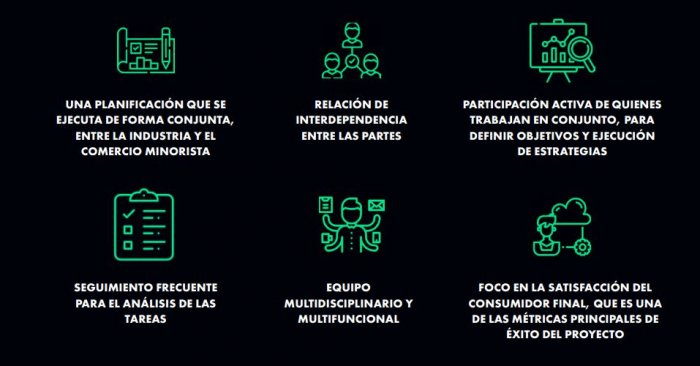
- Planificación ejecutada de manera conjunta entre industria y minorista;
- Relación de interdependencia entre las partes;
- Participación activa de los socios para la definición de los objetivos y la ejecución de estrategias;
- Seguimiento frecuente para el análisis de las tareas;
- Equipo multidisciplinario y multifuncional;
- Enfoque en la satisfacción del consumidor final, siendo una de las principales métricas de éxito del proyecto.
Como dijimos anteriormente, la planificación JBP no se limita a las ventas así como esa estrategia tampoco está relacionada a una larga reunión.
Joint Business Plan requiere un largo estudio sobre el mercado, las empresas implicadas, los objetivos que serán trabajados y la ejecución.
Entre los objetivos de JBP , tu empresa puede aspirar, por ejemplo a:
- El aumento de la facturación;
- El desarrollo tecnológico;
- La expansión de los canales de ventas;
- El fortalecimiento de la marca;
- El aumento del ticket promedio de los productos;
- La creación de nuevos canales de ventas;
- La creación de nuevos productos.
Son varios los objetivos que una empresa puede querer alcanzar, pero es importante priorizar tus elecciones. Si tienes alguna duda sobre cómo crear la planificación de tu empresa o sobre cuál manera hacer la elección de tus objetivos, en este libro detallamos cada fase de la creación del JBP.
¿Por qué mi empresa debería invertir en la creación de un JBP?
Esta es una pregunta muy sencilla de contestar. Las empresas, sin importar el tamaño y el segmento, deben invertir en esta estrategia, ¡porque el JBP trae resultados efectivos !
A continuación, enumeramos algunos de los resultados que tu empresa también puede lograr con este tipo de planificación.
1. Aumento de la representatividad de la empresa en el mercado
Mientras que muchas empresas sólo siguen el flujo para aumentar sus ventas, con JBP las industrias y minoristas hacen estudios y desarrollan estrategias conjuntas para llegar al objetivo final. Con esta alineación, las marcas llegaron a resultados sorprendentes.
«Con las acciones de JBP, hemos logrado más que duplicar la representatividad de nuestra marca en el mercado online y en 2020 podemos incluso triplicar esta expansión. También tuvimos un resultado positivo de gobernabilidad de las acciones de nuestra empresa. Esto significa que hubo una alineación de las acciones de la compañía, hoy todos saben el camino que tenemos que seguir.»
Explica Heloisa Sevciuc, Digital Transformation en Nestlé Purina.
Otra empresa que también tuvo buenos resultados afectados por la expansión del mercado fue Coop, la mayor Cooperativa de Consumo de América Latina. La Coop fue creada hace más de 60 años y la organización tiene experiencia en el desarrollo de la estrategia JBP.
Actualmente la Coop trabaja en este tipo de proyecto con aproximadamente 40 a 50 proveedores, sobre todo con grandes industrias.
«JBP es una práctica frecuente en nuestra rutina. Estamos perfeccionando nuestros procesos cada vez más y tratando nuestros desafíos de forma igualitaria entre la industria y el minorista. Cuando esto sucede, llegan los resultados. En un sólo producto, por ejemplo, conseguimos aumentar la facturación en un 25%.»
Ejemplifica Gustavo Ramos, Director Adjunto de Comercial y Marketing en Coop.
2. Reducción del tiempo promedio de entrega de los productos
Los problemas de logística se encuentran entre los principales desafíos en la ejecución de las empresas, ya sea para marcas que actúan en el entorno online u offline. Este es un problema que afecta a toda la cadena: la industria, el minorista y el consumidor final.
En el caso de Goodyear, la fábrica de neumáticos para autos, el tiempo promedio de entrega de los productos en las regiones Norte y Nordeste duraba más de 30 días, lo que era considerado un largo período por la empresa.
«En la logística que teníamos, los productos salían de la fábrica en São Paulo, seguían hacia el centro de distribución de la empresa en Pernambuco y solo después empezaban las entregas. Este proceso hacía que los clientes recibieran la mercancía con 45 días, cuando no habían imprevistos.»
Explica Maria Liz Fraga, Business Advisor Account en Goodyear.
La solución para el problema relacionado con la logística de la empresa fue uno de los objetivos de JBP de Goodyear. El fabricante reunió a los socios, involucró a los equipos operativos y después de algunas pruebas el grupo llegó a la solución.
«Para llegar al resultado que queríamos, tuvimos que rehacer nuestra ruta de distribución. Con la nueva estrategia, añadimos una nueva forma de entrega, esta vez, saliendo desde São Paulo directamente hasta el destino final. El resultado fue la reducción del tiempo promedio de 45 a 12 días. Esto afectó positivamente a todos los involucrados en el proceso, porque nuestros clientes redujeron el costo de inversiones inmovilizadas en el stock.»
Concluye Maria Liz Fraga.
3. Mejora del vínculo entre la industria y el minorista
Cuando las empresas se comprometen a participar en un Joint Business Plan, se establece una asociación. De esta manera, están unidas por un compromiso que acerca los vínculos.
«Cuando los resultados empiezan a aparecer, el vínculo entre las empresas se mejora más aún, porque los objetivos se construyen juntos. Ganamos una mayor proximidad entre los equipos y esto se refleja en el resultado final», explica María Liz Fraga, Business Advisor Account de GoodYear.
El Director Adjunto de Comercial y Marketing de Coop, Gustavo Ramos, también está de acuerdo con los beneficios sobre los vínculos proporcionados por la ejecución del JBP.
«En la mayoría de los casos, es posible resolver las demandas con conversaciones maduras, con ambos lados descubriendo la raíz del problema y elaborando un plan de acción», concluye Gustavo.
Cómo Lett ayuda a tu marca en la ejecución del JBP
Como ya sabes, planificaciones como las de Joint Business Plan implican grandes objetivos. Esto significa que aunque tienes tu objetivo principal de expansión comercial, existen diversos indicadores clave de rendimiento que tendrás que seguir para lograr el resultado que deseas. En este sentido, los datos de Lett son fundamentales para la ejecución de una buena estrategia.
Mira cómo Lett puede ayudar a tu empresa a alcanzar tus objetivos, habla con uno de nuestros consultores .

© 2023 Titan 7. All rights reserved

What Is a Joint Business Plan (JBP)? Benefits & Best Practices
By 8th & Walton | on October 2, 2022
From small businesses to large corporations, the most successful companies begin and stick with a clear business plan. When a company defines its goals, lays out a path to meet objectives, and agrees on financial spending and expectations, it creates a shared vision and accountability to succeed.
Many businesses experience greater growth when partnering with another business. In the supplier and retailer relationship, both parties working independently would be detrimental. To create a mutually beneficial partnership, they must begin by defining each company’s responsibilities, expectations, and needs in a joint business plan.
What Is a Joint Business Plan?
A joint business plan (JBP) is the collaborative process of planning between a retailer and a supplier in which both companies agree on short-term and long-term objectives, financial goals, growth, and shared business initiatives for profitability.
Joint business planning focuses on agreeing on common objectives and aligning on a single goal or set of goals. The companies in the joint business plan must work together to accomplish a shared vision.
What Is the Purpose of a Joint Business Plan?
For retailers and suppliers, having a joint business plan can create a win-win strategy in growing consumer sales. An effective JBP allows suppliers to build stronger relationships with their retailers so both parties can mutually support and benefit from each other.
When a retailer and supplier recognize each others’ needs and agree on common goals, they can share insights to support each other and improve sales, customer growth, and processes.
How Does a Joint Business Plan Work?
Two companies can come together with a joint business plan because they have one thing in common: a shared shopper . Whether it is a supplier partnering with a retailer or a children’s clothing company partnering with a toy manufacturer, having the same target audience is the first element that brings the companies together.
The companies considering a joint business venture should then share their individual business plans and discuss their mutual growth opportunities. This is where the general goals and areas of support can be defined. Specific tactics and category strategies can also be fleshed out in early discussions before moving to the formal process.
Once both companies are in agreement that the partnership will be mutually beneficial, the joint business plan can be created. Formal contracts are drawn up, approved, signed, and the plan is ready to be executed. Periodic reviews and necessary adjustments to the JBP are recommended as needed.
Benefits of Joint Business Planning
Why enter into a joint business plan with another company? The benefits can be not only financial but educational as well:
- Aligning goals. For a retailer/supplier joint business plan, being aligned on goals creates clarity on all other areas of the business. Defining expectations on all areas from marketing to supply chain to sales goals leaves minimal area for questions. Agreeing on goals, no matter how and when they are measured, keeps both parties accountable and benefits both to meet expectations.
- Shared resources and exposure. Partnering with another company can bring a new audience and a new platform. In a simple retailer/supplier joint business plan, the retailer can introduce the supplier’s product to its core shoppers. At the same time, shoppers loyal to the supplier’s product or brand can be introduced to the retailer’s store and website for the first time.
- Greater return on investment. By partnering with another company with a shared vision, the benefits above will provide a better ROI when the plan is executed correctly.
Joint Business Planning Best Practices
How can companies ensure their joint business plan is a good fit for both parties? These are some best practices to include in preparation for entering into the partnership:
1. Align Internally First
Before entering into a joint business plan with another company, all members of the business must agree on the benefits of the partnership. Recognizing the advantages and seeing the bigger picture is key. When employees are in alignment within the company, it will be easier to align with the partnering company on the shared vision of the joint business plan.
2. Create the Plan Together
When two businesses enter into a partnership, the joint business plan should not be built by only one. A company sending another a complete plan or just a form to fill out is not collaborative. Both companies need to build the plan from the ground up. Collaborating in the development of the joint business plan is just as important as executing the plan itself.
3. Set Specific Goals
Expectations for success in the partnership need to be specific. “We need to grow sales” or “production costs will decrease” are good goals, but too general. Keep specifics in your plan that are as specific as they are realistic. If one company wants to grow sales by 40% in the next quarter, this should be spelled out in the joint business plan so get early support or push back from the other company.
4. Assign a Metric to Each Goal
Putting a metric with a goal keeps the company accountable to the mission of the joint business plan. For example, if the goal is to grow sales by 40% in the next quarter, it would be wise to assign a weekly growth metric. If the metric is too low over a few weeks, the plan shows that action needs to be taken immediately in order to meet the 40% sales growth goal for the quarter.
5. Communicate Responsibility and Accountability
The joint business plan is the place to eliminate all guesswork. If Company A is responsible for providing labels to Company B, be very specific about the responsible parties. Clarify that the packaging coordinator of Company A will mail the labels to the warehouse manager of Company B on the first of the month.
6. Include Risks and Solutions
Planning for setbacks is key to planning for success. The joint business plan should include any possible risks or obstacles foreseen by either company. Having solutions in place for multiple scenarios makes the plan easier to execute.
7. Constantly Evaluate the Relationship
Joint business plans work better with trust, mutual respect, and a great working relationship. Keeping the relationship healthy between the companies and individuals relying on each other brings more success to the overall plan. Monitor the relationship periodically and work to resolve conflicts as they arise.
Joint Business Plans at Walmart
Walmart works with its suppliers to create plans for sales and category growth. The company relies on suppliers to bring insights to the table to spot trends and get in front of potential gaps in the business.
Back in 2011, Walmart created a joint business plan with Proctor and Gamble to pick up lost sales in air fresheners. This category was down over 2% across the chain, but P&G brought insights to Walmart on how consumers were purchasing throughout the industry.
Consumers had no problem going to Walmart for aerosol sprays for under a dollar, but would then go to specialty stores to purchase expensive candles in the same scent. Through communicating through the joint business plan, Walmart was able to create excitement around higher price-point items and show the shared shopper they could purchase the extra items in one store.
Positive business collaborations can be extremely beneficial in growing retail sales. Two companies sharing a common vision can build on each other’s best practices and support each other to mutually win at the register.
Suppliers looking for support in their Walmart business have found great collaboration with 8th & Walton. Our team of experts supports suppliers to improve reporting, analytics, supply chain, accounting, and more. To begin a great collaboration with us, request a free 15-minute consultation this week.
About the Author
8th & Walton consists of retail industry experts with a combined 200+ years of Walmart and Walmart supplier experience. Having helped hundreds of CPG companies in their efforts to be better supplier partners to the world's most influential retailer, the 8th & Walton editorial team prides itself on being a go-to resource for Walmart supplier news and insights.
Related Content

5 Essential Excel Skills for Walmart Luminate™ Users

Suppliers: Adjust Based on 2024 BTS Sales

Walmart DSS Sunsets: How to Prepare for Luminate™

- 4 Min. de lectura
¿Qué es el Joint Business Plan?
Actualizado: 3 mar
En el dinámico mundo del consumo masivo y el retail, la colaboración entre fabricantes y minoristas nunca ha sido más crucial. Aquí es donde entra en juego el Joint Business Plan (JBP). Este enfoque colaborativo no solo fortalece las relaciones comerciales, sino que también impulsa el éxito compartido al alinear estratégicamente los objetivos y recursos de ambas partes.
El juego ha cambiado – y sin embargo, muchos detallistas y sus proveedores todavía operan con las viejas prácticas buscando su própio beneficio, perdiendo valiosas oportunidades para colaborar a través de la generación de insights y estrategias conjuntas.
Por otro lado, mucho se ha escrito en los últimos años acerca de la importancia de la colaboración entre los retailers y fabricantes (iniciativas conjuntas que van más allá del curso normal del negocio del día a día, con el objetivo de alcanzar una mejora significativa en los resultados de mediano y largo plazo). Mientras que la importancia de la colaboración puede parecer obvia, la implementación es a menudo difícil y compleja.
Un Joint Business Plan es una herramienta estratégica colaborativa entre un fabricante y un minorista, diseñada para beneficiar a ambas partes. Al enfocarse en metas comunes, como mejorar la visibilidad de los productos y optimizar la cadena de suministro, un JBP sirve como un roadmap para el éxito mutuo, estableciendo una clara línea de acción y responsabilidades compartidas.

Muchos retailers y fabricantes consideran que la mayoría de las iniciativas de colaboración no han funcionado por falta de compromiso o interés de la contraparte. Cuando analizamos en detalle lo que sucede y conversamos de forma independiente con cada lado, encontramos una profunda frustración por la incapacidad de hacer que la relación funcione bajo sus términos. Escuchamos frases como “el cliente siempre hace lo que quiere”, “no cumple con lo acordado”, “no colabora”.
EXISTE UN CLARO DESCONOCIMIENTO DEL MODELO DE NEGOCIO, ESTRATÉGIA & NECESIDADES DE LA CONTRAPARTE
El retailer piensa en términos de desempeño de tienda, categorías y SKU´s.
El retailer piensa en cómo traer más Shopper a su tienda, cómo aumentar el valor del ticket de compra y reducir costos.
El retailer piensa en aumentar el margen bruto y mark up por categoría y producto.
El espacio de la tienda, es la unidad a ser maximizada en términos de facturación y rentabilidad. ¡Cada m2 cuenta!
El retailer hace comparaciones entre proveedores de la misma categoría.
Fabricantes:
El fabricante piensa en términos de volumen y rentabilidad de un mercado
El fabricante piensa en cómo aumentar el volumen a través de canales y tiendas físicas y digitales
Algunos fabricantes han decidido abrir un canal digital de venta directa a Shoppers, lo que lo coloca como competidor de sus principales retailers.
El fabricante ve las condiciones comerciales como un “costo de venta”.
El fabricante intenta maximizar el Margen Bruto por cada 1.000 unidades vendidas.
El fabricante hace comparaciones entre tiendas, canales y regiones.
¿Cuáles son los principales benefícios del Joint Business Plan?
JUNTOS ganan cuando centran su atención en El Shopper.
Ambas partes dependen del Shopper para hacer crecer su negocio, al mismo tiempo que dependen uno de otro para conseguir influenciar efectivamente su comportamiento de compra. Podemos resumir los principales beneficios en 3 puntos:
Mejora de la Colaboración : La creación de un JBP requiere diálogo y transparencia, lo que fortalece la relación entre fabricante y minorista.
Optimización de la Cadena de Suministro : Al trabajar juntos, las partes pueden identificar y abordar eficiencias, reduciendo costos y mejorando la disponibilidad del producto.
Incremento de Ventas y Rentabilidad : La alineación de marketing y estrategias de ventas conduce a campañas más efectivas y un mayor retorno de inversión.
¿Cuáles son los Elementos Clave de un Joint Business Plan Exitoso?
Objetivos Compartidos : La base de un JBP exitoso es la definición clara y consensuada de metas que benefician tanto al minorista como al fabricante.
Estrategias de Marketing y Ventas : Integrar acciones promocionales y estrategias de venta para capturar la atención del consumidor y aumentar las ventas.
Análisis de Datos y Métricas de Rendimiento : Utilizar datos para tomar decisiones informadas y medir el éxito del JBP regularmente. Por ejemplo, al trabajar en conjunto aumentamos la cantidad y calidad de los datos disponibles para una categoría:
La Cuenta Clave (Retailer):
Es el dueño de la información del TICKET DE COMPRA de cada Shopper.
Tiene adicionalmente información del perfil demográfico de sus clientes a través de los programas de lealtad existentes.
Sabe cuáles son los productos correlacionados al del proveedor por ticket, que facilita la selección de ubicaciones secundarias para la categoría o producto dentro de la tienda.
Es el principal responsable de la Calidad de la Experiencia de Compra que finalmente el Shopper recibe en su tienda.
Es el dueño de las principales categorías y marcas deseadas por el Shopper.
Es responsable por el control de la logística de despacho del producto a la tienda.
Cuenta con información de mercado y tendencias de consumo y compra de la categoría. Adicionalmente cuenta con el soporte profesional de agencias de publicidad y consultoría de mercado.
Tiene información de benchmarking de tiendas similares a las del retailer, lo que le permitiría implementar acciones de mejoría del negocio más rápidamente.
Compromiso y Comunicación : Mantener líneas de comunicación abiertas y un compromiso continuo para adaptarse a los cambios del mercado y ajustar el plan según sea necesario.
¿Cómo Implementar un Joint Business Plan?
Para implementar un JBP efectivo, ambas partes deben:
Establecer una comunicación clara y definir objetivos comunes.
Desarrollar un plan detallado que incluya estrategias de marketing y ventas.
Acordar las métricas de rendimiento y establecer un calendario de revisión regular.
Comprometerse con la transparencia y la adaptabilidad para ajustar el plan como sea necesario.
Basándonos en nuestra experiencia, hemos creado un modelo de servicio conformado por cuatro pasos esenciales para obtener una relación de negocios basada en colaboración efectiva:
¿Por qué vale la pena trabajar el Plan en conjunto?
Cualquier modelo de colaboración exitoso entre dos o más empresas requiere de una estructura fundacional que defina claramente las reglas de juego y los aportes de cada una de las partes para ASEGURAR EL COMPROMISO.
Generación de expectativas mutuamente definidas y alineación de objetivos ¿Qué esperamos alcanzar?
Modelo Operativo ¿Cómo vamos a trabajar juntos?
Aportes (Inputs) y recursos ¿Qué y cuánto vamos a aportar cada uno?
Definición de métricas ¿Qué indicadores son necesarios para evaluar los avances?
Generación de Insights Accionables
Diseño del Plan Conjunto
Seguimiento y Control
El Joint Business Plan representa una estrategia integral para maximizar las oportunidades de mercado para fabricantes y minoristas por igual. Al adoptar un enfoque colaborativo, los gerentes de categoría y cuentas claves pueden superar desafíos comunes y alcanzar nuevos niveles de éxito. En TMC Consultores Comerciales, estamos listos para ayudar a su empresa a desarrollar y ejecutar Joint Business Plans efectivos que impulsen su crecimiento y rentabilidad.
¿Necesitas ayuda? Sólo escríbenos a [email protected]
- Planificación Estratégica
Entradas relacionadas
¿Cómo calcular el beneficio neto de mejorar la precisión del pronóstico de tus ventas?
Criterios de clasificación de tiendas en la industria de consumo masivo
Navegando por la era digital: innovación en modelos de negocio para fabricantes de consumo masivo

What Is Joint Business Planning?
by Ursula Brady | Mar 3, 2022 | Blog Post

Executive Vice President and Chief Merchandising Officer , Sam’s Club (Walmart)
Tectonic Shifts in the Retail Environment
The symbiotic relationship between retailer and Consumer Packaged Goods (CPG) companies has, till now, been able to support steady growth based on demand alone. Now, as the Consumer Goods (CG) industry continues to shift away from organic expansion, the need to reach more customers and engage new audiences is more important than ever.
Let’s dive in to some of the key shifts our customers are seeing in the retail environment:
- Competition: Authentic challenger brands are continually entering the market. According to a recent survey carried out by McKinsey, 30-40% of consumers have been trying new brands and products during the pandemic. Of these consumers, 12% expect to continue to purchase the new brands after the pandemic. More competition = more difficulty obtaining or retaining market share.
- Price Pressures: Global supply chain stress has created a multitude of issues for companies seeking to keep costs down. Disruptions in labour markets have seen 15% of companies with insufficient labour for their facilities to keep up with increases in demand, leading to inflation re-emerging as a significant problem for the first time since the 1970s.
- Regulations: Changing consumer needs are not only encouraging the rise of new, healthier alternative brands but also instigating real legislative change. For example, in October 2022, HFSS (High in Fat, Salt & Sugar) regulations will see a crackdown on promotions for unhealthy food and drinks, which will have serious repercussions for both suppliers and retailers.

Traditional Account Management Is Obsolete
Retail, Wholesale & Distribution Leader , Deloitte Global

These shifts have caused retailers to change the way they do business; the traditional playbook needs to be thrown out and rewritten. The diversification we have seen in channels, models and store formats means that retailers’ expectations for suppliers have changed. And, as increasing numbers of authentic challenger brands come to market, competition has never been higher.
For both retailers and suppliers, Key Account Management (KAM) needs to be revisited. A culture of test & learn in real time needs to be applied to contend with these new market entrants and, with “key accounts contribut[ing] between 40% to 80% of revenue for a branded supplier” in developed markets as indicated by this article by Bain & Company , the time to reinvent is now.
Major incentives for change can be distilled into these three points:

Negotiation Can Feel Like a Zero-Sum Game
In the past, the CPG industry power dynamic has often favoured the supplier, but this is no longer the case. Only 3% of retailers are in an exclusive relationship with just one supplier in a given category, indicating the clout they hold to sway access to consumers is higher than ever before. With a number of Consumer Goods companies falling prey to a one-size-fits-all to their global business models, they have been losing valuable ground to more specialised, relevant competitors.
For CPG companies, visibility at point-of-sale for their products is vital. For retailers, getting the product in-store to sell is their business. Having retailers being ‘on-side’ and aligned is game-changing for suppliers.
But, as indicated in the name, Joint Business Plans need to be exactly that: Joint. If the manufacturers arrive at the table with a railroad agenda, offering little to no agency to the retailer, it will be too one-sided and off balanced. If retailers have unrealistic expectations, e.g broad assortments or 24-hour delivery, from certain suppliers, the equilibrium of the plan will be thrown off from the outset. This is where the value of insight-sharing cannot be understated; IGD asserts that both sides must ‘be prepared to share information with each other’ to achieve success.
Both CPG companies and retailers need to be able to influence the plan and offer respective insights to avoid creating a zero-sum atmosphere.
How Can Joint Business Planning Be Achieved?
For companies collaborating on Joint Business Plans, certain proactive steps need to be taken to fit the plan to benefit both parties. Bain & Company have set out five key steps that they have seen Consumer Goods companies take to achieve ‘more trustful and productive’ relationships and provide significant value.

1. Understand the Retailer’s Economics as Well as Your Own
Entering into a business relationship, such as a JBP, with a full understanding of where a potential partner is in the market is pivotal to a successful collaboration. Being aware of any weaknesses provides the opportunity to address them before they become an issue and impact your business.
In turn, a complete understanding of your own business’ strengths and weaknesses before embarking on any external partnership is equally important. A Joint Business Plan can only be successful if it truly brings benefit to both the retailers and CPG companies; without this, joint commitment can’t be assured.
This demands the creation of an environment where retailers and CPG companies can offer total visibility into their data, thereby enabling creation of target audiences and consumer journeys. As indicated by an IGD Industry Survey , ‘Too often trust is the biggest barrier to putting any proposal into action’. Data transparency reduces the possibility of down-the-line surprises and potential derailing of the plan.
2. Differentiate Your Joint Business Plan and Align It With Your Retailer’s Strategy to Target Shoppers
While keeping costs down may be advantageous, it is vital not to lose sight of the top priority; understanding the target customer segments.
Customer data extracted through the collaborative JBP can help maintain product stock levels, illustrate demand and identify trends in product distribution. Without this information, even a theoretically perfect Joint Business Plan will fail. Understanding who the customers are and what they are buying better enables CPG companies and retailers to produce and distribute – keeping the customer’s needs at the crux of their strategy.
It’s important to note that Joint Business plans are not one-size-fits-all; it may take more time to differentiate a plan to make it more tailored to a specific relationship, but the benefits can outweigh the expense.
3. Have Teams on the Ground Executing Key Customer Touchpoints and Confirming Compliance
Research by POI illustrates that 58% of CPG companies are struggling with retailer aligned compliance for store-level promotion execution. Clearly, there is a concerted need to ensure in-real time that assured promotions are being carried out, but 27% of CPG companies do not get any real-time insights into retailer compliance, forcing them to wait until the end of a cycle to make any significant changes.
While promotion compliance isn’t a new issue in the Consumer Goods industry, it can be a major roadblock to a JBP. With teams in the field, far more regular compliance checks can be performed and the information shared much wider, much faster.
4. Maintain Year-Round Contact With Customers at Multiple Levels and Functions
The dialogue between each party needs to continue beyond initial negotiations and agreements. Regular meetings provide opportunities to correct mid-cycle issues, where the retailer and CPG company can align on real-time results and solutions.
Without clearly defined and tracked performance metrics, the success of the JBP is uncertain. Both parties need to agree on what data sources are going to be reviewed. Expectations must be laid out internally and externally, to establish what each side hopes to get out of the arrangement. This will prevent potential disappointment if or when unaired expectations aren’t met.
It is also important to have discussed and agreed upon the terms and investment in the JBP. Going into a project aware of the value that each business is adding to the other and being able to quantify the ROI is fundamental to a successful Joint Business Plan.
5. Use the Most Advanced Tools and Insights to Stay on Top of Your Joint Numbers
As shown in the recent Promotion Optimization Institute (POI) State of the Industry Report , 64% of manufacturers have challenges when looking for data from retailers. When data is such a foundational element to gainful retailer partnerships, it needs to be shared. The ideal is to involve teams from across the company including distribution, sales, finance and marketing. Siloed internal communication can negatively impact information sharing and lead to failure of a JBP.
CPG companies need to leverage real-time insights pulled from a range of commercial data sources that allow them to optimize strategies based on their business goals and current supply and promotion constraints. This maximises the value of every dollar invested in trade spend.
Aforza & Joint Business Planning
Closely aligned with the tenets of Bain’s Key Account Management Commercial Excellence framework, Aforza drives Joint Business Planning with an end-to-end platform of core functionalities:
- Account 360° View : Gain a complete view of an account’s hierarchies and key relationships, as well as visibility into all engagement activity across channels.
- Real-time Data & Insights on Account Performance: Get real-time insights, from a range of commercial data sources, across all aspects of your key account performance.
- Integrated Trade Promotions: Optimize trade spend and target key customers by displaying a real-time view into promotion performance, inventory levels, sales order insights, budgets & funds, plans & objectives.
- Retail Execution Checks from Field Sales Teams: Leverage your teams in the field to check key account compliance and take promotion-based order capture with penny-perfect pricing on mobile; online or offline .
- Digital Asset Management : Ensuring all important business documents are centralised and accessible against the account, such as contracts and Joint Business Plans.
Check out this demo from Aforza’s Chief Product Officer, Nick Eales, as he showcases how leading Consumer Goods companies are leveraging Aforza to create productive account collaborations that unlock revenue potential like never before:
With industry-leading innovations and capabilities, the Aforza cloud & mobile solution continues to help consumer goods companies sell more and grow faster. Take the first steps now and create productive account collaborations that unlock revenue potential like never before.

Joint Business Plan: What It Is and How to Create One with Your Partners

Are you struggling to align your business goals with your partners? Look no further than a joint business plan. This collaborative approach allows for clear communication, shared expectations, and ultimately, success. Learn how to create one with our guide and take your partnership to the next level.

- Recent Posts

- Chiropractic Business Plan: How to Attract and Retain Loyal Customers - August 3, 2023
- The Major Thrust of Corporate Entrepreneurship is to Create Value and Competitive Advantage - July 31, 2023
- Entrepreneurship Owning Your Future: How to Take Charge of Your Career and Life - July 28, 2023
Are you tired of working with partners who seemingly have different priorities? Does your business lack direction or goals that are aligned with the vision and values of your company? Well, we have good news for you! A joint business plan might just be the solution you need. A joint business plan is a powerful tool that enables you and your partners to set clear objectives, develop strategies, allocate responsibilities, and align your efforts toward a shared vision. So, whether your business is just taking off or it’s been around for a while, a joint business plan can help ensure its success. In this article, we will guide you through the process of creating a joint business plan with your partners, step by step. Trust us; this is something you don’t want to miss!
Table of Contents
1. unleashing the power of joint business plans, 2. why joint business planning is crucial for your partnership, 3. collaboration that works: how to create joint business plans, 4. the benefits of joint business planning, 5. step-by-step guide to crafting joint business plans, 6. assessing your partnership: the first step in joint business planning, 7. aligning your goals: a key element in crafting joint business plans, 8. creating the perfect joint business plan: tips and strategies, 9. implementing and executing your joint business plan, 10. evaluation and review: tools for improving your joint business plan, 11. taking your partnership to the next level with joint business planning.
- 12. Closing Thoughts: Harnessing the Power of Collaboration with Joint Business Planning
Our Readers Ask
Final thoughts.
Joint business plans (JBPs) are the secret recipe for unlocking formidable results in business. JBPs involve collaboration between two or more companies to craft a strategic plan aimed at delivering mutual benefits. When companies partner using JBPs, they can leverage each other’s strengths and use them for the benefit of the collective. This strategic collaboration also enables companies to share risks, maximize profits and enhance their competitive advantages.
Successful JBPs require comprehensive planning, execution, and review. Companies involved in JBPs must align their visions and goals to minimize conflicts and create a symbiotic relationship. With proper planning and strategy, JBPs can help companies create fresh opportunities, increase market share, boost sales, and drive innovation. By working together, companies can achieve what they would have failed to accomplish independently. It’s high time businesses embraced JBPs as they have a proven track record of expanding boundaries and growing businesses beyond what they thought possible. Through JBPs, businesses can harness existing experience, put their strengths to work, and foster productive partnerships to achieve valuable results.
Joint business planning is an essential aspect of building a successful partnership. At the heart of any partnership is the goal of achieving shared success, but this can’t be achieved without a clear plan in place. Joint business planning involves setting out a detailed, actionable plan that identifies specific goals, milestones, and responsibilities. Successful partnerships are built on a foundation of collaboration, and joint business planning is the cornerstone of this.
One of the key benefits of joint business planning is that it creates a shared understanding of what success looks like. This helps all parties to work towards the same goals, aligning their efforts to achieve a common purpose. Joint business planning also promotes accountability and transparency, providing a clear framework for measuring progress and evaluating success. By working together to develop a joint business plan, all parties have a clear view of what needs to be done, how it will be achieved, and who is responsible for delivering it. In short, joint business planning is crucial for any partnership that wants to achieve sustained success.
Creating joint business plans can lead to effective collaboration between businesses. When creating these types of plans, it’s crucial to have a clear understanding of each other’s objectives and goals. By working together, businesses can help each other identify any potential roadblocks and develop strategies to overcome them.
When developing a joint business plan, communication is key. Each party should be open to sharing their ideas and concerns. It’s essential to discuss each other’s strengths and weaknesses and to create a plan that will allow both businesses to benefit. By working together, businesses can find new opportunities to grow their customer base and improve their products and services. To ensure that the plan is successful, both parties should commit to it and stay focused on the end goal.
Joint business planning is a powerful approach that brings together two or more companies to work together strategically. It involves close collaboration to achieve common goals, share resources, and most importantly, boost profitability. The idea behind joint business planning is to create a win-win situation for all companies involved.
One of the significant benefits of joint business planning is stronger relationships between companies. This approach helps to foster positive relationships between partners, which can lead to long-term collaboration. Moreover, joint business planning allows each business to bring its strengths to the table. This helps to create a much stronger overall strategy, which can be leveraged to gain a competitive advantage. In turn, this can lead to increased revenue and profitability for all parties involved. Joint business planning is a valuable tool for any company looking to expand its revenue streams and reach new customers while maintaining quality relationships with its partners.
Crafting a joint business plan with your partner can be a daunting process. But don’t worry, we have compiled a step-by-step guide to make this process as smooth as possible. So grab your favorite drink, sit back, and let’s get started!
1. Align your Goals & Objectives: The first step in crafting a successful joint business plan is aligning your goals and objectives with your partner. It is crucial to have a clear understanding of each other’s vision, values, and desired outcomes. Identify your strengths, weaknesses, opportunities, and threats to come up with a plan that leverages both partners’ strengths and mitigates weaknesses. Keep an open mind and be flexible as the process of aligning your goals can take time. Remember, the goal is to build a sustainable and mutually beneficial partnership. 2. Identify KPIs & Milestones: Once you have aligned your goals, it’s time to get down to business and identify the key performance indicators (KPIs) and milestones that will help measure progress towards your goals. These KPIs should be specific, measurable, achievable, relevant, and time-bound. It’s also essential to set realistic milestones that will help you track progress against the plan. The key is to focus on a few critical KPIs and milestones that will drive the desired outcomes. Remember, it’s better to have a few well-defined KPIs than too many that can cause confusion and lack of focus.
Assessing your partnership is the crucial first step in joint business planning. Your success in business hinges on the strength and health of your partnership, so it’s crucial to determine and evaluate where you stand in terms of communication exchange, accountability, and performance.
It’s essential to assess if you and your partner(s) have a clear understanding of roles, responsibilities, and goals. This process involves reviewing each partner’s contribution to the business, identifying strengths and weaknesses, and decision-making strategies. We recommend identifying Critical Success Factors (CSFs) to measure the progress of your partnership. CSFs could include customer satisfaction, productivity, quality of work, and timely completion of tasks. This assessment should be repeated at regular intervals, at least once a year.
When crafting joint business plans, aligning your goals with your partner’s is crucial. Without this, you may find yourselves hitting roadblocks or even worse, going in completely opposite directions. To avoid this, it’s essential to communicate clearly and frequently with your partner and make sure everyone is on the same page.
One effective way to align goals is to create a shared vision. This should include a clear understanding of what both parties hope to achieve and how it will benefit each other. Don’t be afraid to brainstorm and get creative in generating ideas for this vision. Once it’s established, use it as a reference point and constantly refer back to ensure you’re both working towards the same goals. With a clear vision in place, you’ll have the foundation needed to drive your joint business plan forward.
Joint business plans are essential for successful partnerships, and creating the perfect one requires careful planning and execution. A well-crafted business plan can help you and your partner brainstorm innovative ideas, establish goals, and identify potential challenges and solutions. To ensure that you create a joint business plan that meets both of your expectations, consider the following tips and strategies.
1. Define your goals and objectives: Before starting, it’s essential to define the goals and objectives of your partnership. Take the time to understand each other’s business priorities, strengths, and weaknesses, and how you can complement each other. Clarifying your goals will help you set the direction for the business plan.
2. Communication is critical: Good communication is vital when creating a joint business plan. Make sure you and your partner are on the same page and have open lines of communication throughout the process to capture new ideas and avoid misunderstandings. Regular meetings and progress updates will also help keep everyone aligned and ensure that you stay on track toward your goals. With these tips and strategies, your partnership can be successful and result in a formidable joint business plan.
Now that you and your partner have crafted a comprehensive joint business plan, it’s time to put it into action. The success of your partnership relies heavily on how well you execute the plan. In this section, we’ll cover some essential steps to take in implementing your joint business plan.
First, it’s vital to assign responsibilities correctly. You and your partner should establish clear roles and expectations for each team member involved. Don’t leave any room for confusion or ambiguity. Next, create a timeline with specific deadlines for action items. Once you’ve established a timeline, stick to it as closely as possible. Make sure to communicate frequently with your partner to make sure progress is being made. Lastly, be prepared to make some adjustments along the way, as things may arise that are beyond your control. By working together proactively and communicating effectively, you can successfully execute your joint business plan and achieve your business objectives.
As with any business strategy, evaluating and reviewing your joint business plan is crucial to its success. By doing so, you can identify areas where you need to adjust your approach and make changes that will help you achieve your goals. Fortunately, there are several tools you can use to make this process easier.
First, consider using a SWOT analysis. This involves analyzing your plan’s strengths, weaknesses, opportunities, and threats. You can use this information to refine your strategy and make it more effective. Other tools include regular check-ins with your partner, tracking your progress with specific metrics, and seeking feedback from customers and other stakeholders. Whatever method you choose, make sure you are regularly evaluating your plan’s effectiveness and making changes as needed to stay on track.
Another critical tool for improving your joint business plan is to conduct regular reviews. This can involve reviewing your progress against your goals, analyzing any roadblocks or challenges you’ve encountered, and brainstorming new ideas for growth and development. These reviews should be conducted on a regular basis and involve all stakeholders to ensure that everyone is on the same page and working towards the same goals. By taking the time to evaluate and review your plan, you can ensure that you are always moving forward and continually improving your partnership.
Now that you have established a great partnership with another business, it’s time to take things to the next level. Joint Business Planning is a strategic process that allows both businesses to work together to create a plan that benefits all parties involved. This is an excellent opportunity to align goals, prioritize initiatives, and create a roadmap for success.
Joint Business Planning involves collaboration, communication, and open-mindedness. Both businesses should be willing to share insights, resources, and challenges to achieve the best possible outcomes. Through this process, you can identify opportunities to grow revenue, increase market share, and optimize operations. Moreover, this process ensures that both parties are on the same page in terms of timelines, budgets, and expected outcomes.
Here are some tips to ensure that your Joint Business Planning process is successful:
-Create a shared vision and mission statement that aligns with both businesses’ core values and objectives. -Develop a clear methodology that outlines goals, strategies, and metrics for success. -Identify areas of expertise and assign individuals to take responsibility for specific tasks. -Set realistic timelines and budgets for project phases. -Be transparent, open-minded, and willing to compromise for the greater good.
By investing time and effort in Joint Business Planning, you can take your partnership to the next level and achieve great things together.
12. Harnessing the Power of Collaboration with Joint Business Planning
Joint Business Planning (JBP) is not just another fancy corporate buzzword. It represents a powerful tool that allows collaborators to examine their respective strengths and weaknesses to achieve a common goal. Collaborative teamwork that rests on transparency, honesty, and mutual trust is key to the success of a JBP. In this era of intense competition, JBP has become an essential component of the business strategy that enables companies to survive and grow. Therefore, companies that are willing to harness the power of collaboration as facilitated by JBP are best positioned to succeed in today’s marketplace.
Remember, the JBP process is not a one-time event. It is a continuous process that requires the active participation and commitment of all parties involved. JBP has proven to enhance cohesiveness, efficiency and ultimately the profitability of businesses. It gives the collaborators the best chance of achieving their goals in a way that benefits all parties. Harnessing the power of JBP enables businesses to save costs, reduce risks, and increase revenues by tapping into the knowledge, resources, and expertise of others with complementary skills. So, put your ego aside, and start exploring the benefits of JBP, as it is a proven method to achieve success in the world of commerce.
Q: What is a joint business plan? A: A joint business plan is a document created in collaboration with your business partners that outlines key objectives, strategies, tactics, and timelines for achieving common goals. It’s essentially a roadmap for success that everyone can agree on and work towards achieving.
Q: Why is creating a joint business plan essential? A: Creating a joint business plan is crucial because it helps align the objectives and strategies of all parties involved. It reduces misunderstandings and conflicts that may arise from different interpretations of goals and expectations. Additionally, it ensures that everyone is on the same page and working towards the same end result.
Q: How do you create a joint business plan with your partners? A: To create a joint business plan, start by coordinating with your partners to determine shared objectives, values, and priorities. Next, identify key performance indicators (KPIs) and milestones to help measure progress and track success. Develop targeted strategies and tactics for achieving these goals, and establish clear timelines and accountability measures.
Q: Who should be involved in the joint business plan process? A: Ideally, all partners should be involved in the joint business plan process. This includes stakeholders, executives, managers, and other key decision-makers. However, the specific roles and responsibilities of each individual may vary depending on the nature of the partnership and the goals outlined in the plan.
Q: What are some benefits of using a joint business plan? A: The benefits of using a joint business plan are many. It helps increase accountability, promote collaboration, and improve communication between partners. It also helps avoid misunderstandings and conflicts that can arise from differing interpretations of goals and expectations. Overall, it’s a powerful tool for achieving business success.
Now that you know about joint business plans, it’s time to take the leap with your partners and start creating a practical roadmap for your business. With a solid plan in place, you can achieve your goals faster and achieve success with ease. Remember, collaboration is key in every business, and in joint planning, you get to leverage the strengths of every partner, to maximize your output. So, don’t hold back, get your partners together, and create an effective joint business plan today. Trust me; it’s the best decision you’ll make for your business!

Business Writer
A dynamic business writer with a talent for uncovering the latest trends and innovations in the world of startups and entrepreneurship. With a background in finance and a passion for storytelling, Morgan’s articles offer a unique perspective on the challenges and opportunities facing today’s business leaders.
Similar Posts

Small Business Flight Plan: How to Plan, Execute and Achieve Your Business Goals in 2023

Small business owners dream of taking their enterprises to new heights, but without the right flight plan, those aspirations can stay grounded. With 2023 fast approaching, it’s time to buckle up and develop a robust roadmap for achieving those business goals. Here’s how to take off and soar to success.

Business Exit Strategy Consulting: How to Plan and Execute a Successful Exit Strategy for Your Business

If you’re a business owner, preparing an exit strategy may not be at the top of your to-do list. However, planning for an eventual exit ensures that you’ll be able to maximize your company’s value and benefit from your hard work. In this article, we’ll explore why exit strategy consulting is important, and provide you with tips for planning and executing a successful exit strategy for your business.

7 Stages of Business Growth: What They Are and How to Navigate Them Successfully
Every business goes through a series of stages as they grow and evolve. Understanding these stages can help entrepreneurs navigate the journey from startup to thriving business. In this article, we’ll explore the 7 stages of business growth and provide tips for successfully navigating each one.

Joint Business Planning: A Collaborative Approach to Achieving Strategic Goals

Are you tired of implementing business strategies that don’t quite hit the mark? Joint Business Planning could change your game. By bringing all stakeholders to the table, this collaborative approach ensures alignment towards your shared goals. Want to observe your business soar? Give Joint Business Planning a try today!

Business Continuity Management Framework: A Guide to Best Practices and Standards
Business Continuity Management Framework is essential for ensuring that organizations can continue to operate even in the face of disruptions. This guide provides a comprehensive overview of best practices and standards to help organizations develop effective BCM strategies. By following these guidelines, businesses can safeguard their operations and minimize the impact of disasters.

Chiropractic Business Plan: How to Attract and Retain Loyal Customers
Are you struggling to attract and retain loyal customers to your chiropractic business? Look no further! A solid business plan is the key. From creating a welcoming atmosphere to maintaining consistent communication, we’ve got the tips you need to succeed. Let’s get started!

Planes conjuntos en el Retail (JBP) y los Tableros de Control Compartidos.
por Carlos Enrique Osorio F. | Nov 13, 2019 | Retail

Entender la cadena de valor desde el shopper hasta las industrias permite comprender las tareas de los diferentes participantes y valorar su ejecución de forma justa y equilibrada en busca de la sostenibilidad que está demandando el shopper de hoy. Es la evolución del entendimiento de los negocios desde la madurez de la ambición empresarial.
Planes de negocios conjuntos en el retail (JBP)
Los planes de negocios conjuntos en el retail o Joint Business Planning (JBP) son una herramienta colaborativa poderosa que da alineación a las estrategias, objetivos, acciones y metas entre dos aliados comerciales, usualmente un proveedor industrial y un retail . Un plan de negocios conjunto (JBP) permite el entendimiento integral de la cadena de valor de un producto e identifica las pérdidas de valor que suceden por procesos duplicados, mala comunicación, logística inapropiada e incluso precios erróneos entre otros factores.
Iniciar el entendimiento del mercado desde la mente de los shopper siempre es un origen válido, verlo en conjunto entre un proveedor y un retail es mucho más que acertado.
La sinergia del conocimiento de las variables comerciales junto con la experticia del conocimiento de los productos y las categorías por parte del productor es un punto de quiebre en la carrera por lograr la eficiencia comercial y de las categorías, que trae beneficios esenciales para los shopper , al mejorar el precio y por lo tanto el acceso a los productos y sus innovaciones, factor importante igualmente para las compañías y los comercios al incrementar los volúmenes y dinamizar los portafolios.
Información e inteligencia de negocios compartida
Compartir información y conocimiento sobre el desempeño de la cadena de valor y en especial del comportamiento del shopper es un buen punto de partida en el desarrollo de planes conjuntos. Lo común es que un plan inicia con información y con un análisis situacional, el desarrollo de un plan conjunto no es la excepción, incluso su potencial es mayor al integrar información que abre nuevos escenarios de análisis y oportunidades.
Una de las prácticas más avanzadas y efectivas es la construcción de tableros de mando o Dashboard de información que integre el desempeño de los productos y las categorías y que pueda ser visible por las partes. Esta práctica permite concentrarse en información útil para ambas partes y el negocio, desarrollar estrategias más precisas y determinar las inversiones apropiadas para las categorías y productos, especialmente identificando en que parte de la cadena de valor debe realizarse.
Un dashboard compartido no solo permite un análisis más afinado del desempeño de las categorías, sino también permite hacer un seguimiento de la gestión ( accountability ) más preciso, mejora la toma de decisiones y permite desarrollos avanzados de analítica que facilitan aprender más rápido de los resultados y de los comportamientos derivados de las decisiones del negocio tomadas por los diferentes actores en la cadena.
Los dashboard que poseen optimizadores de portafolio aportan importantes elementos adicionales orientados a mejorar los flujos de caja y el uso del capital de trabajo. Los optimizadores agregan importantes recomendaciones orientadas al logro de las metas en los niveles superiores de los indicadores ( KPI ) del Balance Score Card , que en términos prácticos son los grandes resultados del negocio relacionados a la rentabilidad del activo tanto para el productor como para el retail y/o comercializador.
Vivir la experiencia de trabajo conjunto
La experiencia de desarrollar un JBP y ejecutarlo es enriquecedora, retadora, fascinante y está llena de expectativas. El trabajo conjunto esta llamado para un nivel superior de madurez empresarial al que todas las compañías deben avanzar. La falta de confianza empresarial y comercial, la ambición por tener mejores rentabilidades sobre cadenas de valor ya casi definidas y elementos culturales limitan a que los desarrollos de negocios sean más rápidos, innovadores y cercanos a las necesidades del shopper .
Los beneficios del trabajo colaborativo tiene alcances que superan lo simplemente comercial. Cuando dos culturas se interrelacionan suceden cambios que hacen que las Organizaciones evolucionen, aprendan y identifiquen la importancia de la ejecución conjunta. Es común que en toda relación de estas características uno de los participantes este más evolucionado empresarialmente, incluso para esta Compañía hay frentes de aprendizaje a aprovechar de su nuevo colaborador en los negocios, especialmente desde el entendimiento del shopper .
El concepto de shopper en su esencia debe ser un importante integrador y es la orientación de los esfuerzos de colaboración. La ciencia del estudio del shopper tiene importantes avances, sin embargo aún falta mucho por profundizar, lo cierto es que en un tiempo cercano las herramientas de predicción serán mucho más acertadas y los espacios de la analítica matemática avanzada y la inteligencia artificial – AI tendrán un gran protagonismo, iniciarán por las grandes corporaciones y sin duda tendrán que llegar a las pequeñas compañías, comerciantes y retail .
Hoy, es indiscutible la necesidad de iniciar el manejo de los dashboard de visualización y control de los indicadores, así como los optimizadores, para poder facilitar la evolución a herramientas que harán más eficiente la ejecución comercial.
Los elementos clave de un Joint Business Plan – JBP y sus herramientas.
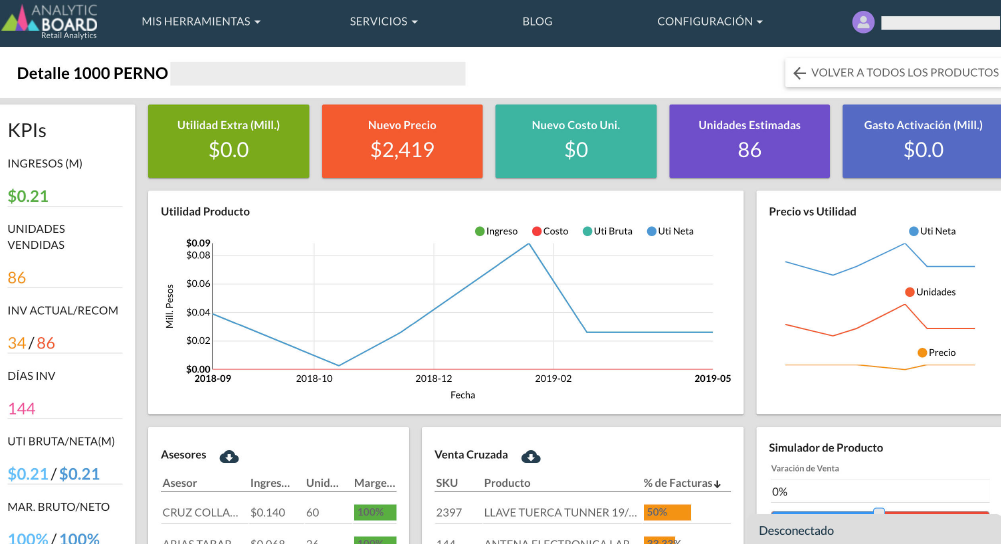
Los Joint Business Plan – JBP son un derivado de las buenas prácticas de desarrollo comercial y del retail , creado por agremiaciones mundiales líderes como: Grocery Manufacturers Association (GMA), Food Marketing Institute (FMI), National Association of Chain Drugstores (NACDS), Global Commerce Initiative(GCI), GS1 , entre otras, quienes estructuraron metodologías colaborativas disruptivas en el mundo del retail como el “ New Ways of Working Together ” que se convierte en el marco de referencia de desarrollo del retail moderno, sobre el cual las grandes compañías vienen indudablemente trabajando y otras vienen implementando algunos elementos. Esto es sin duda una tendencia que ha abierto nuevos horizontes en la comercialización frente a los enquistados procedimientos de negociación dura que lideraron el escenario a finales del siglo XX.
Entre las herramientas clave para la implementación y/o preparación para estas nuevas metodologías se encuentran:
- El desarrollo de los perfiles de los Shopper y/o consumidores
- El compartir la información del negocio y los KPI
- El desarrollo de la Cultura, las competencias y la estructura organizacional
- El compartir los procesos y la cadena de suministros
Las nuevas metodologías colaborativas incluyendo los planes conjuntos – JBP utilizan las anteriores herramientas clave en diferentes grados de profundidad y con sentidos de sinergia que pueden diferenciarse según los retos del mercado y participantes, eso si, siempre deben estar orientados hacia la maximización del entendimiento del mercado y su valor contenido en el consumidor y el shopper .
Las plataformas de inteligencia de negocios y su gran valor inicial
En los procesos colaborativos la variable más importante es el compromiso de la Dirección de ambas Compañías y como segundo esta toda la dinámica de compartir información. Tener la información en dashboard de control y visualización y plataformas de inteligencia de negocios funcionales facilita de manera definitiva los procesos de compartir información, y es uno de los caminos que llevan a resultados tempranos de los esfuerzos compartidos.
Los dashboard de control o tableros siempre son un punto de partida sólido, por lo que siempre es deseable que tanto las industrias como el retail posean un dashboard de control con énfasis comercial que permita tomar las riendas del negocio y tener claras las fuentes de generación de valor para la compañía.
Independiente de la tecnología empleadas en los dashboard de control bien sea tableros de control especializados en comercio como otra plataformas estándar como Power BI, Tableau, Qlik u otras, siempre será deseable su uso activo y permanente por parte de las Organizaciones involucradas en la colaboración. Los dashboard de control adicionalmente permiten parametrizar los protocolos de acceso que protejan la integridad de los participantes y los datos sensibles para otros participantes de los negocios. Tener claridad sobre los alcances en el acceso a la información y unas reglas claras que respeten la información sensible para todos los participantes, facilita la construcción de confianza y la posibilidad de sentarse juntos a comprender desde otra perspectiva los negocios y los mercados.
También te puede interesar El arte del retail marketing y los nuevos 4 pilares de éxito.
Artículos Recientes

- septiembre 2022 (1)
- enero 2022 (1)
- agosto 2020 (1)
- enero 2020 (1)
- noviembre 2019 (1)
- octubre 2019 (1)
- septiembre 2019 (5)
A Guide to Joint Business Planning Best Practices

Joint business planning is a crucial aspect of fostering successful collaborations between companies. In today’s dynamic business environment, strategic partnerships have become increasingly prevalent, making it essential for organizations to adopt effective joint business planning best practices. This article will explore the key principles and strategies that contribute to successful joint business planning, providing insights […]

If you need assistance from our team, click here .
- Updated at 03/21/2024
- Be the first to comment.
Joint business planning is a crucial aspect of fostering successful collaborations between companies. In today’s dynamic business environment, strategic partnerships have become increasingly prevalent, making it essential for organizations to adopt effective joint business planning best practices. This article will explore the key principles and strategies that contribute to successful joint business planning, providing insights into how businesses can optimize their collaborative efforts for mutual growth and success.
Table of Contents
The Importance of Joint Business Planning in Today’s Market
In an era defined by rapid change and increasing interconnectivity, the significance of joint business planning cannot be overstated. This section explores how businesses can gain a competitive edge, foster shared vision, and unlock mutual growth opportunities through effective collaborative strategies.
Competitive Advantage and Shared Vision
Joint business planning serves as a catalyst for companies seeking a competitive advantage in the market. When organizations come together to strategically plan and align their strengths, they create a synergy that surpasses individual capabilities. This subsection delves into how collaborative efforts can amplify competitiveness by leveraging the unique strengths of each partner.
A shared vision is the cornerstone of successful partnerships. This subsection emphasizes the importance of establishing a common understanding of long-term goals and objectives. By aligning visions, businesses can enhance cooperation, minimize conflicts, and work towards a unified purpose. Effective joint business planning ensures that all stakeholders are on the same page, promoting a cohesive approach to achieving shared goals.
Mutual Growth Opportunities and Win-Win Strategy
Joint business planning creates a framework for identifying and capitalizing on mutual growth opportunities. This involves exploring synergies between partners, uncovering complementary strengths, and strategically leveraging resources. This subsection explores how collaborative planning facilitates the identification of avenues for joint growth, leading to mutually beneficial outcomes.
The essence of successful joint business planning lies in adopting a win-win strategy. This involves creating scenarios where all parties involved stand to gain, fostering a collaborative environment based on trust and reciprocity. This subsection delves into the principles of a win-win approach, showcasing how it not only enhances the success of partnerships but also builds a foundation for long-term, sustainable relationships.
Core Elements of Effective Joint Business Planning

Collaboration is only as strong as the foundation it is built upon. This section delves into the essential elements that underpin successful joint business planning, emphasizing the importance of aligning business strategies, sharing shopper and marketplace insights, and cultivating collaborative working relationships.
Aligning Business Strategies for Success
Central to effective joint business planning is the alignment of business strategies. This involves harmonizing the goals, tactics, and overarching plans of collaborating entities. By ensuring strategic congruence, partners can maximize the impact of their combined efforts. This subsection explores the intricacies of strategic alignment and how it forms the bedrock for successful joint business planning.
Effective joint business planning goes beyond immediate gains; it incorporates a holistic approach that integrates both short-term wins and long-term objectives. This subsection discusses how businesses can synchronize their timelines and milestones to create a comprehensive strategy that facilitates sustainable success.
Shared Shopper and Marketplace Insights
An integral aspect of joint business planning is the sharing of shopper insights. By pooling data and understanding consumer behavior and preferences, partners can tailor their strategies to meet evolving market demands.
This subsection delves into the importance of shared shopper insights and how they contribute to more informed decision-making in collaborative endeavors.
In a dynamic marketplace, staying ahead requires constant awareness. This subsection explores how joint business planning encourages the exchange of marketplace intelligence. Partners can adapt to changing trends, capitalize on emerging opportunities, and navigate challenges more effectively by combining their knowledge and resources.
Collaborative Working Relationships
At the heart of effective joint business planning is the cultivation of collaborative working relationships. Trust and open communication form the backbone of successful partnerships. This subsection explores strategies for building trust among partners and fostering an environment where transparent communication is prioritized.
Collaboration often involves navigating unforeseen challenges and capitalizing on unexpected opportunities. This subsection discusses the importance of flexibility and responsiveness in joint business planning, emphasizing the need for partners to adapt and evolve together in a dynamic business landscape.
How to Create an Effective Joint Business Plan

In the pursuit of successful collaborative ventures, crafting an effective joint business plan is paramount.
This section outlines the key steps involved in creating a robust plan, covering aspects such as setting joint objectives, resource allocation, and addressing legal considerations.
1. Setting Joint Objectives and Account Management
The foundation of any joint business plan lies in establishing clear and achievable objectives. This subsection explores the importance of defining shared goals, aligning strategies, and ensuring that all stakeholders are committed to a common purpose. Clear objectives provide a roadmap for collaborative efforts, guiding partners toward mutual success.
Effective account management is crucial for the seamless execution of joint business plans. This involves assigning responsibilities, creating accountability structures, and establishing communication channels.
Delving into the intricacies of strategic account management, this subsection highlights how a well-organized approach contributes to the overall success of collaborative initiatives.
2. Resource Allocation and Shared Resources
Resource allocation is a critical aspect of joint business planning, ensuring that both parties contribute and benefit equitably.
This subsection explores strategies for optimizing the allocation of financial, human, and technological resources. By balancing contributions, businesses can enhance efficiency and maximize the impact of their collaborative efforts.
Collaborative ventures often involve the pooling of resources to achieve common goals. This subsection delves into the concept of shared resources, emphasizing how partners can leverage each other’s strengths to overcome challenges and capitalize on opportunities.
Efficient utilization of shared resources enhances the overall effectiveness and sustainability of joint initiatives.
3. Formal Contracts and Legal Aspects
A crucial step in creating an effective joint business plan is the establishment of formal contracts. This subsection explores the importance of clearly defined agreements, covering aspects such as roles and responsibilities, dispute resolution mechanisms, and exit strategies.
Robust contractual frameworks provide a solid foundation for trust and transparency between collaborating entities.
Navigating the legal landscape is essential for the success and longevity of joint business ventures.
This subsection delves into the legal aspects involved in collaborative efforts, addressing issues such as intellectual property, confidentiality, and compliance. Understanding and addressing legal considerations from the outset safeguards the interests of all parties involved.
Best Practices for Joint Business Planning Execution
Effective execution is the linchpin of successful joint business planning. This section explores best practices that organizations can adopt to ensure the seamless implementation of collaborative strategies, including the use of performance metrics, monitoring, accountability, and value chain analysis.
1. Performance Metrics and KPIs
Setting and monitoring performance metrics are essential elements of joint business planning execution. This subsection delves into the process of defining key performance indicators (KPIs) that align with the shared objectives of the collaborative venture.
By establishing measurable benchmarks, organizations can gauge the success of their efforts and make informed decisions to optimize performance.
Performance metrics should not be static; instead, they should be subject to continuous evaluation. This subsection emphasizes the importance of regularly assessing KPIs, analyzing performance data, and adapting strategies based on the evolving needs of the collaboration.
A dynamic approach to performance measurement ensures that joint business plans remain responsive to changing market conditions.
2. Monitoring and Accountability
Effective monitoring is a cornerstone of successful joint business planning execution. This subsection explores proactive monitoring strategies, including the use of technology, regular communication channels, and real-time data analysis.
By staying vigilant and responsive, organizations can identify potential issues early on and take corrective actions to maintain the trajectory toward shared goals.
Clear accountability structures are vital for the success of collaborative ventures. This subsection delves into the importance of defining roles, responsibilities, and expectations within the partnership.
Establishing accountability structures fosters a sense of ownership among all stakeholders, ensuring that each party contributes actively to the joint business plan’s execution.
3. Value Chain Analysis and Multi-functional Execution
Conducting a value chain analysis is a best practice that can significantly enhance joint business planning execution. This subsection explores how organizations can identify value-creation opportunities at each stage of the collaboration.
By optimizing the value chain, partners can streamline processes, reduce costs, and deliver enhanced value to customers.
Collaborative ventures often involve the integration of multiple functions within each organization. This subsection discusses the importance of multi-functional execution, emphasizing the need for seamless coordination across departments.
By breaking down silos and promoting cross-functional collaboration, organizations can ensure the holistic implementation of joint business plans.
Creating Value Through Customer Focus
In today’s customer-centric business landscape, creating value for consumers is at the forefront of successful joint business planning.
This section explores strategies for placing customers at the center of collaborative efforts, enhancing consumer sales, and elevating the overall customer experience.
How to Create Value for Customers Through Joint Business Planning
A fundamental step in creating value through joint business planning is gaining a deep understanding of customer needs and preferences. This subsection explores how organizations can leverage market insights, customer feedback, and data analytics to identify and prioritize customer-centric initiatives.
By aligning collaborative strategies with customer expectations, businesses can create offerings that resonate with their target audience.
Effective joint business planning involves co-creating solutions that address specific customer pain points. This subsection emphasizes the importance of collaboration in ideation and product development, showcasing how partnerships can bring together diverse perspectives and expertise to deliver innovative solutions.
Co-created offerings not only meet customer needs but also differentiate the collaborative venture in the market.
Consumer Sales and Customer Experience
Joint business planning can significantly impact consumer sales by optimizing distribution channels, expanding market reach, and aligning sales strategies. This subsection explores how organizations can leverage their collaborative efforts to boost consumer sales. Whether through joint marketing initiatives, bundled offerings, or cross-promotions, aligning sales strategies enhances the overall success of the partnership.
Customer experience is a critical differentiator in today’s competitive market. This subsection delves into how joint business planning can be structured to elevate the customer experience.
From seamless transactions to personalized interactions, collaborative ventures can enhance every touchpoint in the customer journey. Focusing on customer satisfaction not only builds loyalty but also contributes to the long-term success of the collaborative partnership.
In conclusion, the journey through the intricacies of joint business planning best practices has highlighted the pivotal role that effective collaboration plays in today’s dynamic business environment.
From aligning business strategies and setting joint objectives to executing plans with a customer-centric focus, the success of collaborative ventures hinges on a thoughtful and strategic approach.
Frequently Asked Questions (FAQs)
What are the key metrics to measure the success of a joint business plan.
Measuring the success of a Joint Business Plan involves tracking key metrics such as revenue growth, market share expansion, customer satisfaction, cost savings, return on investment (ROI), and adherence to compliance and risk mitigation.
These metrics provide a comprehensive evaluation of the collaborative venture’s impact on both financial and operational aspects, ensuring a holistic assessment of the plan’s effectiveness.
How do you resolve conflicts during the Joint Business Planning process?
Resolving conflicts during the Joint Business Planning process requires an open communication approach, identification of root causes, and, when needed, the involvement of a neutral third party for mediation.
A clear definition of roles and responsibilities, the establishment of conflict resolution protocols within the joint business plan, and a focus on shared objectives contribute to addressing conflicts promptly and fostering a collaborative environment.
What role do executive sales leaders play in Joint Business Planning?
Executive sales leaders play a pivotal role in Joint Business Planning by strategically aligning sales efforts with overall business goals, contributing to resource allocation discussions, cultivating relationships with key stakeholders, providing market insights, and overseeing the performance of sales teams.
Their involvement ensures that sales strategies complement the collaborative venture’s objectives, driving success in terms of revenue and market impact.
How often should a Joint Business Plan be reviewed and updated?
The frequency of reviewing and updating a Joint Business Plan varies but commonly involves quarterly reviews for timely adjustments based on market changes and annual updates for comprehensive reassessment of long-term goals. Additionally, trigger events such as major market shifts or significant internal changes may prompt unscheduled reviews.
Adapting the frequency based on the dynamic nature of the business environment ensures the plan remains relevant and responsive to evolving conditions.
Are there any software tools that can facilitate Joint Business Planning?
Various software tools facilitate Joint Business Planning, offering features such as collaboration, data analysis, project management, and document sharing. Platforms like Microsoft Teams, Slack, or Asana enhance communication, while tools such as Tableau or Power BI aid in data analysis. Project management software like Trello or Jira helps in planning and tracking progress, and CRM systems like Salesforce or HubSpot centralize customer interactions and sales activities. The selection of tools depends on the specific needs and preferences of the collaborating organizations.
Leave a Comment Cancel Reply
Your email address will not be published. Required fields are marked *
Save my name, email, and website in this browser for the next time I comment.
- RFID System for Inventory Control
- Real time Inventory Control
- Controle Patrimonial
- Inventario Patrimonial
- Reavaliação de Ativos
- Empresa de Inventario de Estoque
- Empresas de Valuation
Business Valuation
- Como Implementar ESG
- Certificação ESG para empresas
- Due Diligence
Fixed Asset Inventory and Reconciliation
IT Asset Inventory Management
Fixed Asset Reconciliation
Property Tax Solutions
Baseline Asset Inventory and Tagging
Machinery and Equipment Valuation
Cost Segregation Studies
Property Record Outsourcing
Wall-to-Wall Inventory Audit
Cycle Counts
MRO Inventory Solution
Electronic Shelf Labelling Installation
Commercial Staff Support
Asset Impairment Testing
Intellectual Property and Intangible Asset Valuation
Tangible Asset Valuation
Real Estate Valuation
ASC 842 Advisory Solution
RFID Asset Inventory Tracking
Effective Digital Supply Chain with RFID
Asset Management and Maintenance with RFID
Warehouse RFID Inventory Tracking
Real-Time Location System (RTLS)
RFID Tracking for Car Inventory
RFID Tags, Labels and Readers
Related Content to Business Valuation

Warehouse Stock Counting Techniques
Discover efficient warehouse stock counting techniques to enhance your inventory accuracy and optimize your management strategies.
RFID Tracking Devices: Enhance Your Asset Control
Elevate your asset management with our advanced RFID tracking devices. Secure, efficient, and accurate control for your inventory.
RFID Warehouse Tracking System: Maximize Efficiency
Discover the power of an RFID warehouse tracking system and elevate your inventory accuracy while streamlining operations for unparalleled efficiency.

Chemical Inventory Management Software: Maximize Safety
Streamline your lab safety and compliance with our cutting-edge chemical inventory management software. Efficient tracking, simplified reporting.
RFIC: What is a radio frequency integrated circuit and how does it work?
Discover the essentials of RFICs, their pivotal role in wireless tech, and how they drive modern communication systems to new heights.

Understanding ROU Asset Tax Treatment Essentials
Discover how ROU asset tax treatment can affect your financials and learn to navigate the complexities of depreciation and tax implications effectively.

What is Lease Term 1 Mos? Understanding Short-Term Leases
Explore the intricacies of a lease term 1 mos – your guide to navigating the nuances of short-duration rental agreements.


Walmart RFID Mandate: What You Need to Know
Discover the essentials of Walmart’s RFID mandate and how it impacts suppliers. Learn about compliance requirements and the benefits of this retail technology.

Leading RFID Label Manufacturers | Custom Solutions
Discover top RFID label manufacturers offering custom solutions for asset tracking and inventory management. We provide high-quality smart labels and RFID tags for your business needs.

RFID Integration: Elevate Your Inventory Management
Explore the transformative potential of RFID integration in your inventory management to streamline operations and boost efficiency.

Maryland Warehouse Inventory Services | Optimize Management
Elevate your Maryland-based warehouse’s efficiency with our top-notch inventory services. Expert solutions for tracking, control, and optimization.
RFID Tracking for Reusable Transport Items (RTIs)
In today’s fast world,

RFID Architecture in a Shopfloor: Seamless Integration
Explore how RFID architecture in a shopfloor can streamline your inventory management and boost operational efficiency.

Advanced Identification Solutions: Products, Fixed Assets, Animals and People
Explore our advanced identification solutions for secure asset and identity management across people, animals, and fixed assets.

LPN Barcode Solutions for Efficiency
Explore our LPN barcode solutions to streamline your inventory tracking and enhance operational efficiency. Unlock the power of precision in logistics.

Effective Operating Room Inventory Management
Discover how effective operating room inventory management optimizes surgical supply tracking, reduces waste, and improves patient care in healthcare facilities.

Fixed Asset Tagging System: Streamline Inventory Management
Discover how our fixed asset tagging system revolutionizes inventory management. Streamline tracking, reduce errors, and boost efficiency. Implement smarter asset control today.

Indefinite-Lived Intangible Assets: Key Insights
Explore indefinite-lived intangible assets with our comprehensive guide. Learn about valuation, accounting, and management of these crucial business assets.
Asset Tracking in Hospitals: Enhance Efficiency
Discover how our advanced asset tracking solutions optimize hospital operations, improve patient care, and reduce costs. Streamline your healthcare facility today.

Surgical Inventory Management Solutions
Optimize your surgical inventory management with CPCON’s cutting-edge solutions. Streamline processes, reduce costs, and enhance patient care in your healthcare facility.
Recent Content

With over 25 years of experience, the CPCON Group is the global advisor that enhances and maximizes organizations’ internal control, promoting increased management efficiencies, improved regulatory compliance and financial supervision.
More about CPCON
80 Broad Street, 5th Floor, Manhattan, 10004
[email protected] +1 (201) 366-2960

How to Create an Effective Joint Business Plan

For two businesses to form a joint venture, they need a plan that outlines the nature of the business coalition. A joint business plan defines the state of the companies involved, the purpose of the joint business and the partners’ responsibilities.
A joint business plan describes all the activities that these business ventures must carry out to achieve specific goals.
The relationship between the two parties and their goals must be clearly understood. After creating the business plan, it must go through a legal review to test its legitimacy. In your business planning, you work together in a collaborative relationship toward mutually agreed terms.
Business planning for joint ventures helps the parties leverage resources, reduce costs, combine expertise and/or enter foreign markets. A well-defined joint business plan is vital for any agreement and business strategy.
What is a joint business plan?
A joint business plan is a document that defines a merger between two or more companies. It describes the purpose and responsibilities of each partner in the incorporation. You may also see it as a collaborative process of planning where a supplier and retailer agree on both long- and short-term goals, including growth, finances and shared initiatives for profitability.
The purpose of a joint business plan is to design a win-win strategy for increasing consumer sales. This plan allows the partners to build a formidable relationship with retailers for mutual support and benefits. Having agreed upon goals, both parties share insights on a common vision for better support, customer growth, enhanced process and improved sales.
Business planning depends on interested parties sharing their plans with defined mutual growth opportunities. The partners can detail and share strategic planning, growth strategy, tactics and any area of competitive advantage.
The joint business plan is created once a partnership agreement is mutually beneficial and defined. Parties would draw up, approve and sign a formal contract before the execution of the plan. This is followed by a periodic review of joint scorecards based on necessary performance metrics to fine-tune strategies.
The joint business planning process comprises every possible logistic, including human resources planning and how to reach project milestones. Resource accountability is vital to building trust. Your best tool for transparent resource use and accountability is a resource planner .
If the employees of the venture will need to go to a different location, the venture will likely have difficulty planning their tasks and locations. TimeTrack Auto-Scheduling provides joint ventures with a transparent planning tool that reduces effort and enhances error-free shift planning.
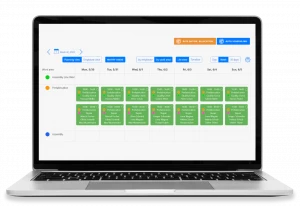
TimeTrack Auto-Scheduling
Types of joint business plans
Standard plan.
This is often referred to as the working plan. It offers an overview of the company, outlines its goals, and details when and how entrepreneurs wish to achieve the goals. Such a plan helps secure funds, investments or loans. Within the plan, you could specify how you will use investor funds and their potential profits.
What-if plan
Sometimes things don’t go as planned in business. The what-if business plan defines the various roadblocks that a company might face as it strives to achieve its business objectives. The venture is largely at the whims of external factors, including the supply chain and stock market. You need to outline a predictable scenario to let business partners know how to recover their funds.
One-page plan
While a detailed plan is vital, there are instances where you will need to provide an abridged version of your plan. This one-page business plan outlines the summary of demand, solution, model, management team and action plan.
Start-up plan
A business plan for entrepreneurs, especially those in the early stages of their business planning, will need a start-up business plan. It is designed to give potential investors the bigger picture and outline how you want to achieve your goals. It often includes an executive summary, background, product and service descriptions, market analysis, costs and financial projections.
Expansion plan
This is a business plan that’s necessary when you need to scale your business and identify the necessary resources for its development. These could be financial investment, an additional workforce, new products or raw materials. This plan will detail the business background, needed resources and how they will contribute to growth and business expansion.
Operational plan
An operational business plan revolves around near-term goals , especially those you will work towards achieving within a year. It defines the activities your venture will focus on and emphasizes the role of the workforce and budgeting in achieving the operational goals. In most situations, the heads of departments are key participants in the operational plans because of the need for approval in achieving the goals.
Strategic business plan
This is different from the others because it focuses on how departments can work together. This venture plan is more comprehensive and requires senior-level approval before implementing goals. This plan answers the questions of how to achieve goals, what resources are needed and the execution plans for achieving the goals.
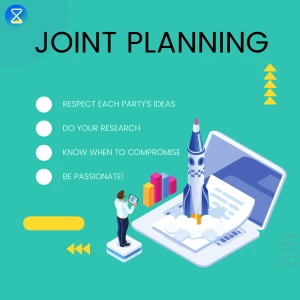
Joint business planning tips
Companies that benefit from a joint business plan
A joint venture exists mainly as a contract between new cooperating partners. In forming a joint venture, each of the business partners agrees to the assets they will bring to the table and how income and expenses will be shared.
While a joint venture is a corporation between two or more entities, each of the companies, be it an individual, company, corporation or group of individuals, still has its original legal status, though not all joint ventures result in a new business entity. These companies could be sole proprietorships or partnerships, limited partnerships, corporations, limited liability companies or non-profit organizations.
Examples of a joint business plan
Perhaps you have an online venture selling high-quality products at reasonable prices, while needing to increase brand strength. Such an example of a joint business plan outlines a company overview, executive summary, product and service offerings, marketing strategy, market analysis, budget and financial planning.
A joint business plan may be designed for ventures rendering menu services such as lattes, espresso, coffee, cappuccinos, and sandwiches. The business plan outlines an executive summary and studies your competition , target market, marketing plan, ownership structure and operational plan.
A joint venture could be designed around offering services such as shipping, faxing, postal and copying to residents to conduct research , create debate space and generate ideas. This example of a business plan will include an executive summary, a vision and mission statement, goals, objectives, and measures, organizational structure, marketing analysis and a financial plan.
Top strategies for effective joint business plan
In a joint business venture, there are risks which include rising complexity, cultural diversity, high failure rates and language diversity. The strategies detailed below will benefit the venture in navigating the challenges through effective joint business planning.
Strategic plan
Strategic global planning is an effective business practice for entering a new market. It helps to identify opportunities and threats. Before beginning strategic planning, be sure that a joint venture is the right action for you. Compare the strengths and weaknesses of the partners to confirm a good match. Your strategic plan should explain why you want to collaborate with that partner and what you hope to achieve, how to monitor trends and collect good data. Some of the reasons you may wish for a new joint partner may be to enter a new market, geographic expansion, financing, etc.
The right partner
The choice of partner is crucial, but what is more important is understanding the effectiveness of partners in delivering on their promises. Do your due diligence on your partner’s attitude toward collaboration, performance and level of commitment. What about sharing the same objectives?
Effective communication for a great relationship
After your investigation, if you deem the partner fit, find mutual ground. Communication is the key to a good relationship. Make sure your partner understands the foundation of the joint venture and agreement. Ensure they agree on human resources, financial contributions and goals. To consolidate the stability of your venture, be upfront, honest and transparent about your objectives.
Clarify how, what, and where
Be clear on the vision, strategic plans and scoreboard to ensure that everyone is energized and united about the goal. Define a common working pattern. This has to include conflict management, decision-making, collaboration, problem-solving and technology strategies. Focus on win-win solutions.
Track performance
Is everyone putting in the hours and making productive headway? One way to gauge this information is by time tracking. One of the challenges for companies whose employees work in shifts and in different locations is tracking attendance. TimeTrack Attendance Tracking helps companies monitor employees’ work hours and leave days, so that managers can stay up to date on potential delays.
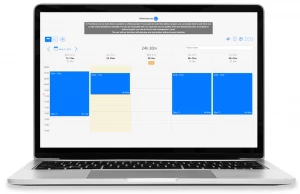
TimeTrack Attendance Tracking
Once you have set out the goals and vision for the new venture, establish key performance indicators, the data you want to track and the process to measure those performance metrics. This involves creating a joint scorecard for each metric against trends and competition. The targets you set must guard against possible problems the partners might encounter.
Build trust
Your best joint business strategy is to build trust and create value, without which your partnership is bound to fail. Trust is the foundation of every partnership. It is an important factor in business planning. Without it, neither partner can succeed. How do you manage diverse cultures, interests and languages if the partners lack trust? Trust builds team strength and encourages creativity while promoting collaboration.
Good leadership
The cost of poor leadership is so high that you must not venture into joint partnership without assurance of good leadership. Focus on building good leadership and not just creating “bosses”. Leadership presents the biggest opportunities to change the performance narrative. Create a strong leadership team, from whom all employees can learn.
A joint business venture is not without its challenges. To ensure a successful collaboration, focus on a clear strategy, excellent communication, transparency and strong leadership.

I am a researcher, writer, and self-published author. Over the last 9 years, I have dedicated my time to delivering unique content to startups and non-governmental organizations and have covered several topics, including wellness, technology, and entrepreneurship. I am now passionate about how time efficiency affects productivity, business performance, and profitability.
You might also like

Newly Launched - AI Presentation Maker

Researched by Consultants from Top-Tier Management Companies
AI PPT Maker
Powerpoint Templates
Icon Bundle
Kpi Dashboard
Professional
Business Plans
Swot Analysis
Gantt Chart
Business Proposal
Marketing Plan
Project Management
Business Case
Business Model
Cyber Security
Business PPT
Digital Marketing
Digital Transformation
Human Resources
Product Management
Artificial Intelligence
Company Profile
Acknowledgement PPT
PPT Presentation
Reports Brochures
One Page Pitch
Interview PPT
All Categories
Top 10 Joint Business Planning Templates with Examples and Samples

Siranjeev Santhanam
If there’s one ingredient behind the success of large and powerful corporations, it is teamwork and collaboration. When corporate entities break down barriers and engage in open communication with mutual respect and a shared vision, great results follow. This collective spirit is the fuel behind some of the business world’s greatest achievements, from epoch-defining products like the iPhone to new and disruptive industries such as clean energy, generative AI and private space travel.
Companies that dominate their field understand the immense potential of joint ventures and strategic alliances. They can help a firm unlock new opportunities, gain the competitive edge, and achieve shared goals that would be beyond the reach of any single entity by itself. At the heart of these successful collaborations lies a crucial element: joint business planning.
Are you planning to start a coffee shop? We’ve got something made just for you. Click here and peruse our other blog on some must have coffee shop business plan templates now.
Such endeavours are crucial to the world of business, and they serve critical advantages. Managers can harness the power of joint business planning to define the purpose and objectives of a project, to align companies’ strategic goals and priorities across departments, and develop a comprehensive action plan with defined roles and responsibilities.
In this blog, we’re going to be taking a look at some joint business planning templates. These pre-designed slides offer a creative canvas upon which you can regulate your business procedures, imposing clarity and cogency during such brainstorming sessions within the corporations.
Are you seeking to understand strategic planning better? Then let us lead the way. Click here and check out SlideTeam’s other blog focussed on five-year strategic business plan templates now.
Template 1 - Joint Business Plan Five-Process Steps
This slide offers a simple and easy method of measuring the effectiveness of a joint business plan, with five separate phases. Foundation, discover and align, initiative planning, execute and monitor and review are the constituent phases of the slide. These offer a solid foundation upon which a team leader can create a productive and fruitful business meeting.

Download now
Template 2 - Joint business plan including consumer and retailer
This template has been molded to serve a consumer-retailer dynamic, and incorporates a simple but powerful methodology that can raise efficiency during joint business planning. The five stages of the slide are foundation, discover and align, initiative planning, execute and monitor and review. There is room for never ending customization with the slide and its internal substance. Make use of this simple one-page PPT to bring more fervor to your strategic business partnerships.

Template 3 – 5-steps process of joint business plan
Embrace the power of joint business planning with this one-page slide that aims to tap into the transformative potential of strategic collaboration. It has been divided into five phases and each phase comes with the benefit of small, segregated content brackets where managers can add sufficient notes for the meeting. Inspire and strengthen your partnerships and ignite synergies that transcend corporate boundaries by taking advantage of this template.

Template 4 - Three phases o f joint business plan
Recognize the pivotal need for collaboration in business and harness it to its full capacity. This one-page PPT can assist you in this, with three critical phases that underpin the joint business planning process. Execution - alignment and analysis, company and account strategic planning, and scenario modelling are the three elements of this template. Use this slide to catalyze growth within your corporation and unleash new partnerships that bring revenue into your firm.

Template 5 - Joint Business Planning Observations Sheet
This one-page slide is a PowerPoint sheet crafted to create stronger channels of growth. The slide has been segmented into three areas - insights, observations and implications. There are other pivotal elements incorporated into the slide that are central to the joint planning process, such as assortment, pricing and promotions, and marketing. Lay the groundwork for a solid partnership by establishing a strong foundation for collaboration, co-operation and shared business, by downloading and utilizing this slide.

Template 6 - Steps to improve joint business plan result
This PPT Template, a one-page slide, is a great asset for firms engaging in a partnership, allowing managers to capitalize on the synergy of the partnership to drive tangible results. Two segments make this slide a class apart, the retailer and supplier relationship, with subheadings incorporated across the breadth of the slide such as develop plans, identify strategy and goals, and a list of smaller segments that can be calibrated to serve partnership needs, such as identifying mutual opportunities, developing a joint category, and more.

Template 7 Joint Business Planning Strategies to Accelerate Growth
This slide is made with the goal of strengthening strategic partnerships in business and creating a culture of adaptation and growth within your joint venture. The subheadings layered into the PPT are improve operations, deliver improved customer value, traffic building, disruptive innovation, etc. There are smaller content brackets for comments underneath each segment. Use this one-page PPT to monitor progress in your efforts, plant the seeds of success, and identify areas for improvement.

Template 8 Joint Business Planning Icon to Retain Partner Engagement
This PPT Template acts as a blank canvas that you can tailor to suit specific needs. With its capacity for boundless customization, the slide can act as a backdrop for a strong and integrated joint planning process. Integrate your own unique brand identity into the fabric of this powerful tool. Its minimalist aesthetic is sure to appeal to the business environment, allowing managers to weave intricate details into the presentation with ease to gain maximum results. Get it now.
Template 9 - Meeting goals of joint business plan
Take control of the meeting and impose a powerful collaborative environment, all with the aid of this sufficiently designed, one page template. It features a list of components that make for an effective joint business plan, such as understanding from both sides, increase trust between parties, more transparency and visibility, joint ownership responsibility to work and progressive sharing of plan. Download this slide and harness its contents to unleash a truly productive business alliance that works wonders.

Template 10 - Emerging Trends in Joint Business Planning
This PPT Slide is a powerful tool for managers seeking to understand the utilities of a joint business plan. It lists a series of emerging trends within this specific niche, all of them color-coded and further enhanced with content brackets underneath. Cost effective collaboration, reliable supply chain, data driven efficiency and sustainable initiatives are the components of this slide. Take advantage of this PPT to create an integrated business planning methodology that works out for both sides during such an exchange.

SYNERGY IS IMMENSELY POWERFUL
The synergy of large groups of people working in harmony powers the world of business. Joint business planning events are more than mundane meeting events where suits work to raise shareholder value. These can be vibrant meeting events that help to cultivate a sense of shared responsibility and collective zeal among the workers of two corporations, giving them the ability to achieve more. Our pre-designed templates can act as a valuable framework where you address the aspects of a joint business meeting. Fully harness the structure, key elements, and internal content of these slides to gain the most out of your joint business meetings, setting your collaborations on a path to success.
PS Are you working to initiate a car dealership business? Rest your anxieties, we’ve got just what you need. Click here and read our other blog on must have car dealership business plan templates.
Related posts:
- How to Design the Perfect Service Launch Presentation [Custom Launch Deck Included]
- Quarterly Business Review Presentation: All the Essential Slides You Need in Your Deck
- [Updated 2023] How to Design The Perfect Product Launch Presentation [Best Templates Included]
- 99% of the Pitches Fail! Find Out What Makes Any Startup a Success
Liked this blog? Please recommend us

Top 10 IoT Templates with Samples and Examples

Top 10 Real Estate Listing Marketing Plan Templates with Examples and
This form is protected by reCAPTCHA - the Google Privacy Policy and Terms of Service apply.

Joint Business Plans: Top Tips for Successful Retail Collaboration
Our top tips on how to develop a joint business plan with your retail partner..
Aug 21, 2023

Joint Business Plans (JBPs) are strategic collaborations between suppliers and retailers to drive mutual growth and achieve shared business objectives. These plans outline the joint activities, goals, and strategies that both parties will undertake to grow retail sales, enhance profitability, and improve the overall performance of the partnership.
JBPs are usually negotiated once a year, at the start of the retailer's financial year. Most things that happen in that year such as distribution changes and promotional space offered are usually dictated by the JBPs; that doesn’t mean that changes not specified in the JBP won’t happen but in general, they influence the year’s decisions.
Here's a few of our top tips to developing Joint Business Plans:
1. understand the retailer's business objectives:.
Gain a deep understanding of the retailer's overall business strategy, goals, and priorities.
2. Align with retailer's strategy:
Ensure your business objectives align with the retailer's strategy. Identify areas where your brand or product can contribute to the retailer's goals.
3. Gather data and insights:
Collect relevant data and insights to support your JBP. This includes market research, consumer trends, sales data, and shopper behaviour analysis.
4. Develop strategies and action plans:
Work together with the retailer to develop strategies and action plans that will help achieve your defined goals.
5. Communicate and review:
Maintain open and regular communication channels with your buyer throughout the JBP implementation. Schedule periodic meetings to review progress, share insights, discuss challenges, and make any necessary adjustments.
6. Accountability & Conditionality:
Within the JBP it’s likely you’ll have invested in the retailer to gain additional space or get new products listed etc. Ensure you only pay investment that was linked to changes once that change has been completed by the retailer; this is referred to as conditionality.
Conclusion:
Remember, a successful Joint Business Plan requires strong collaboration and a focus on mutual growth. By aligning goals, strategies, and resources, suppliers and retailers can create a powerful partnership that drives sustainable business success.
You might also like:

Understanding Retail Investment
Navigating the world of investments in retail is a critical task, especially for startups, so let's delve into key strategies for crafting a compelling proposal that benefits both you and the retailer.

The Pros and Cons of Promoting During Retailer Events
Retailers’ promotion calendars are full of seasonal and event driven promotion timings, so with extra space and Pos up for grabs, should you be investing during these times or not? We delve into the pros’ and cons so you can consider these in your decision making.
Sign up to our community
Get retail insights delivered to your inbox
Valuable insights
Retail-focused
Perfect for challenger brands

Complimentary Learning Resource from CMKG.ORG
Joint business planning resource guide.

Ten Best Practices for Better Joint Business Planning

We recently led an alliance team through an alliance business planning session. Through that process we captured a number of best practices that lead to better business planning and ultimately better performing alliances. Here is what we learned:
- Develop the business plan with your partner. Successful alliances are win/win/win . Your partners’ strategic objectives, resources, commitment and creative insight are critical to the process and to a successful outcome for you, your partner, and your joint customers.
- Use the templates and checklists as stimuli for thought not a rigid formula. Your alliance is unique. The value creation thought process and business plan should reflect that.
- Build from the specific to the general. You may find that over several initiatives you have 80% commonality, but it is that 20% differential that makes for a successful joint offer. Specifics make an impact – generalizations put you to sleep.
- Articulate the differentiation in the solution clearly, unambiguously. Contrast with the competition…50% more scalable than .
- Individual value propositions should include specific descriptions of how value is created, so that a reader not in the alliance understands it. You will be describing the value of this alliance to executive management and other stakeholders.
- Include customer value and metrics .Hard metrics on customer value ie. “reduces deployment costs by 7%”, gives you a compelling reason to get in the door with customer decision makers and energizes the sales teams to engage collaboratively. Value props that impact customer business model are especially compelling i.e. increased competitive advantage for your customer. Focusing on your customer maintains common vision between partners.
- Keep focus on specifics: – “saving millions per drill head” is a more powerful vision than ‘saving costs’; “ saving up to $5M per well” even better! Same for alliance objectives, again, the best have very clear, numerically stated objectives for both partners and customer.
- For each metric establish a baseline “where you are today” and a goal “where you want to be in 6 mo, 1 yr”
- Identify risks and obstacles to success and include risk mitigation and contingency plans
- Evaluate your sales and marketing value props from the sales perspective. Are they strong enough to compel you sales teams to want to sell with a partner?
- Bonus Best Practice: Relationship strength is critical in an alliance. Measure it regularly via partner health checks and proactively manage the relationship.
Related Posts

Do you have a Recession Strategy for Alliances?

How Do You Know If Your Partner Ecosystem is Healthy?

Do you know why you need a Repeatable Delivery Model?
Joint Business Plan: what's the point? .
It’s around this time that manufacturers and retailers agree joint business plans, or JBPs, for the coming year. But JBPs can be a very mixed bag, so if you’re going to do one, it’s essential you do it in the right way and for the right reasons. JBPs come in just three flavours, so which one is right for each of your major relationships?
The Sales Plan:
It’s the most common form of JBP but, in reality, it’s nothing more than a 12-month promotion calendar. Periods of trading, interspersed with launches and deals. It’s a low-value exercise. At best it helps you coordinate activity, stock, and investment across the year, but it’s never going to transform your businesses, so don’t waste much time on it.
The Battle Plan:
This flavour of JBP is really a competitive negotiating tool, to be used to gain specific commitments and concessions. A retailer may be offered extra promotions for a cost price increase. A manufacturer might be promised volume growth in return for more investment. The numbers in the plan are only there to support the negotiation, and to be used as a beating stick, for one side or the other, during the year. It’s a hard-nosed deal for a 12-month period, so it needs time, focus and planning.
The Strategic Plan:
The “strategic” JBP is very different. It requires an open, collaborative relationship. It starts with an ambitious vision of where the relationship could be in the future, where it could add genuine value for customers, and where it could create something new, different and worthwhile. The strategy is as much about joint initiatives as it is about buying and selling, and it may outline a plan that will run for the next several years.
BOTTOM LINE: you can’t collaborate with someone intent on competing with you. But for those relationships where you can collaborate, the rewards from a strategic JBP can be huge. Choose the right approach, set appropriate objectives, and adopt a style to maximise the opportunity. Don’t waste your time going through the motions – there’s really no point.
More Articles .
- How to build an innovation culture
- Unlocking extraordinary potential
- A parable of leading change
- The strategic solution to price pressure
- The foundation of everything
- Preparing to thrive in testing times
- Why bother with strategy
- The thought of work
- Building an innovation ecosystem
- Making progress out of conflict
Article Categories .
- Business Strategy (47)
- Getting Change Delivered (24)
- Leadership in Action (52)
- Innovation and Growth (42)
- Winning in Your Market (37)
- Turning Performance Around (21)
- Sales and Profitability (66)
Cómo hacer un business plan y cuáles son los elementos esenciales para el éxito
Por Douglas da Silva, Web Content & SEO Associate, LATAM
Última actualización en 13 diciembre 2022

El business plan o plan de negocios es aquel que se forma en la incubadora de la empresa . Es decir, es la estrategia que cualquier emprendedor debe llevar a cabo en el proceso anterior a la creación de la empresa .
Las empresas que hacen un plan de negocios inicial crecen hasta 30% más rápido de las que no y pueden llegar a aumentar sus ventas por encima del 90% de un año para otro. Sin embargo, ¿sabías que el 80% de las empresas no lo hace y fracasa?
Esta herramienta permite plasmar la idea de negocio, con todos los detalles necesarios para evaluar y tomar la decisión de concretar una empresa. Entonces, para completar la respuesta de qué es un business plan: es un documento en el que se incluyen los aspectos esenciales de la empresa y del mercado en el que se insertará .
Los elementos esenciales que incluye son:
- Oportunidad;
- Estrategia;
- Financiación;
¿Estás pensando en iniciar una empresa? Necesitas conocer cómo hacer un business plan eficiente y qué contiene un plan empresarial completo. Continúa leyendo y descubre:
- Objetivos del business plan;
- ¿Qué contiene un plan empresarial? 9 elementos del plan de negocios;
- Software para implementar tu business plan.
Objetivos del business plan
Ahora que ya sabes qué es un business plan, es momento de responder cómo hacer uno que sea eficiente . En este caso, si quieres que tu empresa crezca y lo haga de forma constante, debes tener claros los objetivos para desarrollar un plan de negocios.
Entre las metas más importantes que debes considerar al momento de hacer tu business plan, se encuentran:
- Crear una estructura empresarial y definir puntos de referencia e índices de seguimiento para medir el progreso y el rendimiento del equipo.
- Evaluar el atractivo de la empresa y resumirlo en una propuesta de valor. Es decir, aquellas cualidades por las que los clientes se sienten atraídos y deciden elegirte.
- Definir pautas de la empresa de forma igualitaria en los grupos de trabajo así como una visión general—misión y visión de la empresa.
- Fuente de financiamiento para la empresa.
Para cumplir con estas metas, debes utilizar un lenguaje claro y ser objetivo. Además, es importante no extenderse demasiado, ya que podría causar confusión en el business plan.
Si quieres conocer un método inteligente para plantear tus objetivos, lee: ¿Cómo establecer metas de ventas y lograrlas?
¿Qué contiene un plan empresarial? 9 elementos del plan de negocios
Cuando te planteas cómo hacer un business plan eficiente, debes tener en cuenta una serie de elementos que no pueden faltar:
Resumen ejecutivo
El resumen ejecutivo está diseñado para captar la atención de los encargados de tomar las decisiones de la empresa y los inversores. Debe incluir la información principal del plan de negocios, para ofrecer un panorama general del proyecto.
Puedes estructurarlo así:
- Introducción: Explicar de forma breve y concisa de qué se trata el documento, objetivos y beneficios.
- Valor de la empresa: Describir la identidad del negocio, equipo, productos o servicios y clientes; y resaltar el valor del proyecto para atraer inversionistas.
- Análisis de mercado: Indicar las tendencias del mercado y las particularidades de la industria en la que se insertará tu compañía.
- Responsables de gestión: Aquí debes mencionar a los responsables del proyecto y cuáles son sus capacidades para llevarlo a cabo. Demuestra que tu personal es idóneo para transmitir confianza y seguridad a los inversores.
- Proceso de comercialización: Explica cómo será el proceso para concretar tu plan y comercializar tu producto o servicio. Agrega los elementos prácticos y concretos que te ayudarán a llevar a cabo tus objetivos: estrategias de marketing o de ventas, por ejemplo.
- Finanzas: Necesitas comunicar los datos financieros más relevantes. Destaca métricas , presupuesto, precios, ROI y proyecciones financieras.
- Invitación: Para concluir, puedes invitar y motivar a los lectores a sumarse al proyecto.
- Contacto: No olvides brindar información de contacto, para que los posibles inversores puedan contactarte u ofrecer feedback sobre tu proyecto.
Producto o servicio
También, es fundamental analizar las tendencias del mercado y cómo el producto podría funcionar dentro de él. Por ejemplo, si tu producto o servicio se comercializará por internet, necesitarás saber que existen 4.54 billones de usuarios de internet en el mundo .
Además, es preciso analizar si se trata de un negocio local, nacional o internacional. También, debes ampliar la información de acuerdo al tipo de producto o servicio que ofreces.
Equipo de gestión
El equipo de gestión es esencial a la hora de estructurar el plan de negocios. Un grupo de personas capacitado puede aumentar las posibilidades de éxito de la empresa.
Tu organización debe disponer de un equipo con una visión en común y objetivos claros en relación al negocio. El trabajo en equipo es fundamental, pero se recomienda formar grupos de entre 3 y 6 personas para mantener su productividad a tope.
El equipo de gestión no solo debe analizar la situación actual de la empresa. También necesita conocer tanto los éxitos anteriores de la compañía como los de la competencia.
Descubre cómo optimizar tu equipo de gestión en: Matriz de roles y responsabilidades —qué es y qué ventajas tiene .
Mercado y competencia
En este punto, es clave conocer cuál es el atractivo de la industria y la facilidad para captar clientes dentro de esta. Para ello, es necesario realizar un estudio de mercado profundo, que analice:
- El tamaño del mercado y su crecimiento;
- La segmentación del mercado (por qué escoges un grupo de clientes y no otro) elegida;
- Las empresas de la competencia que más potencial tienen y por qué tu producto o servicio podría destacarse.
Además, debes conocer cuáles son las necesidades de tu público objetivo e identificar cuáles cubrirá tu producto o servicio.
Aprende cómo hacer análisis FODA y planificar estrategias exitosas para tu negocio para optimizar el análisis del mercado y tu competencia.
Marketing y ventas
¿Qué función tiene el marketing y ventas en el business plan? Establecen cómo se promocionará el producto o servicio. En este apartado, se añaden sus características específicas, como:
- Canales de distribución;
- Promociones (a empresas y a consumidores);
- Alianzas comerciales.
También, puedes analizar cuál es el producto que mejor funciona dentro de la empresa y por qué. Para ello, es recomendable realizar encuestas a clientes .
Otro aspecto a tener en cuenta es el marketing de fidelización , que se utiliza para conseguir la lealtad de los clientes. Esta acción da como resultado —si están contentos con la compra— la recomendación del producto o servicio a más personas. Con ello, te aseguras una buena presencia en el mercado.
Modelo de negocio
En este apartado debes establecer qué ofrecerá tu empresa al mercado y de qué manera logrará sus objetivos de ventas. Es decir, es momento de elegir la fórmula que te permitirá alcanzar tus metas de la manera más exitosa.
Entre los elementos más importantes que deberás definir, se encuentran:
- Los canales que utilizarás para alcanzar a tu audiencia;
- La realidad económica y financiera de tu empresa: posibilidades de pago y nivel de endeudamiento posible;
- El panorama general de las acciones que deben realizarse para alcanzar los objetivos;
- Los roles y responsabilidades de los colaboradores de la empresa.
Plan de implementación
En el plan de implementación es necesario definir, de manera práctica y concreta, cuáles serán las acciones necesarias para alcanzar cada objetivo.
También, puedes agregar quiénes serán los encargados de llevar a cabo cada una y los recursos necesarios para lograrlo. Aquí, la tecnología es un factor clave: puedes implementar un sistema de atención al cliente o un CRM que impulse y garantice los objetivos de tu negocio.
Riesgos y oportunidades
En este apartado puedes anticiparte a las posibles dificultades con las que se encontrará tu negocio. Esto te permitirá diseñar las soluciones más efectivas para combatir los obstáculos antes de que se presenten.
Además de los problemas, puedes prever oportunidades que podrían surgir en el camino y diseñar las acciones necesarias para sacarles el mejor provecho.
Planificación financiera
En la planificación financiera es importante mostrar a los inversionistas cuál es el atractivo y por qué deberían apostar al negocio. Ten en cuenta que buscan negocios rentables, innovadores, que ofrezcan un valor al cliente y que puedan destacarse en el mercado.
En esta instancia, debes dejar claro los principales supuestos, así como el estado de resultados, flujo de caja y balance. Añade también una proyección de la empresa de entre 3 y 5 años y la rentabilidad asociada.
¿No sabes por dónde empezar? Puedes leer: Cómo calcular el precio de un producto en 4 pasos
Software para optimizar la implementación de tu business plan
El plan de negocios es una parte fundamental en la prospección de una empresa . Por eso, es indispensable aprovechar las herramientas tecnológicas adecuadas que te guíen en el proceso de crearlo e implementarlo.
Ahora que ya conoces qué es un business plan, cómo se hace y qué contiene un plan empresarial efectivo, es momento de entrar en acción. Para garantizar que todo funcione correctamente, puedes aprovechar el CRM de ventas de Zendesk .
Se trata de una solución muy fácil de incorporar y ofrece diversos productos escalables y flexibles para acompañar el crecimiento de tu compañía.
Además, este sistema ofrece múltiples beneficios para optimizar y facilitar el trabajo de tus colaboradores y crear experiencias de calidad y personalizadas a tus clientes . Entre sus ventajas, se destacan:
- Recopilación de información clave sobre tus clientes y su comportamiento de compra;
- Visualización completa de tu embudo de ventas;
- Generación de insights para medir el desempeño de tu equipo de ventas.
Lleva la implementación de tu business plan a un nuevo nivel con Zendesk. ¡Solicita una demostración y descubre todos los beneficios que tiene para tu nuevo negocio!
Relatos relacionados

Artículo 6 min read
Marketing de fidelización: 3 casos de campañas de exitosas.
Entiende qué es el marketing de fidelización. Tipos de programas, acciones y ejemplos + casos de éxito de Amazon, Starbucks y Best Buy.

Hábitos de consumo y tendencias de CX en 2024
Entiende qué son los hábitos de consumo y cómo afectan a tu negocio. + 4 herramientas para conocerlos y analizarlos.

Artículo 8 min read
7 factores que afectan la productividad y cómo lidiar con ellos.
Conoce los factores que afectan la productividad dentro y fuera de la oficina + 4 cosas que deberías hacer para ser más eficiente en ventas.

¿Qué es Marketing conversacional y cuáles son sus beneficios?
¿Qué es el marketing conversacional? Características, beneficios, ejemplos y la herramienta para implementarlo en atención al cliente.
O que é Joint Business Plan (JBP) e como ele otimiza a relação indústria e varejo?
Entenda como funciona o Joint Business Plan (JBP) e o seu impacto para fortalecer uma parceria estratégica entre indústria e […]

Entenda como funciona o Joint Business Plan (JBP) e o seu impacto para fortalecer uma parceria estratégica entre indústria e varejo
O Joint Business Plan (JBP) é uma das principais ferramentas para dar suporte e criar uma parceria sólida entre indústria e varejo. Com abordagem colaborativa, promove resultados positivos para todas os envolvidos, até o consumidor final.
Para isso, gera-se um conjunto de estratégias que vai muito além das transações comerciais tradicionais, ajudando empresas a se destacarem em um mercado cada vez mais dinâmico e competitivo.
Você já aplica o JBP na sua estratégia? Neste artigo, vamos explorar o que é o JBP e porque sua implementação é vital para fortalecer a parceria entre indústria e varejo.
O que é o Joint Business Plan – JBP?
O Joint Business Plan, ou Plano de Negócios Conjunto na tradução, é uma estratégia colaborativa que, geralmente, envolve fabricantes e varejistas. Assim, cria-se um plano de negócios compartilhado com ações de médio e longo prazos.
Ao invés de focar somente na transação de produtos, o JBP alinha objetivos, metas e estratégias para traçar um crescimento mútuo e sustentável, indo muito além da típica relação comprador-vendedor.
Com isso, promove uma parceria mais profunda e integrada. O planejamento dessa estratégia envolve um estudo aprofundado sobre o mercado, as empresas envolvidas, os objetivos que deverão ser trabalhados e a execução, por exemplo.
Importância do JBP na cadeia de suprimentos
A implementação do Joint Business Plan tem uma grande importância na operação da supply chain, já que transforma as transações tradicionais, estabelecendo uma parceria estratégica dos fornecedores com os varejistas .
Assim, as empresas ganham no alinhamento estratégico, otimizam a eficiência operacional e impulsionam a inovação. A estratégia ganha muito com esse método, já que as empresas passam a compartilhar metas e insights, possibilitando atender a dinâmica do mercado de forma mais eficaz.
O JBP não apenas fortalece as relações, mas também cria uma base sólida para o futuro do negócio, garantindo uma posição sólida no cenário comercial desafiador.
5 pontos chave para o planejamento do JBP
Algumas empresas já evoluíram tanto na efetividade do JBP, que atingiram o Joint Value Creation (JVC), que consiste no trabalho em colaboração para a gerar mais valor a quem dita o ritmo do mercado: o consumidor.
No entanto, ainda há uma grande quantidade de empresas que têm espaço para aprimorar o modelo JBP. Abaixo, listamos 5 elementos essenciais para levar em consideração ao elaborar essa estratégia.
1. Entenda o consumidor:
O JBP coloca o cliente no centro de todas as operações. Por isso, é preciso conhecer informações sobre preferências do consumidor, comportamentos de compra e feedbacks.
Assim, indústria e varejo têm argumentos para adaptar estratégias e oferecer produtos e serviços que atendam com precisão às necessidades do consumidor.
2. Alinhamento estratégico:
O JBP inicia com o alinhamento de metas e objetivos estratégicos entre a indústria e o varejo. Isso vai além dos resultados imediatos, abraçando uma visão mais ampla para que as duas partes possam experimentar excelentes resultados.
Essa sincronia estratégica cria uma base sólida para a colaboração contínua.
3. Colaboração de ponta a ponta:
Ao contrário dos modelos tradicionais, onde as estratégias são muitas vezes desenvolvidas unilateralmente, o JBP envolve todos na criação do plano de negócios.
A indústria e o varejo contribuem com insights, conhecimentos, dados e expertise específicos, resultando em um plano abrangente e mais robusto.
4. Compartilhamento de informações:
Uma característica fundamental do JBP é o compartilhamento transparente de informações, mesmo que elas sejam críticas à operação. Isso inclui dados de vendas, previsão de demanda , insights de mercado e até desafios operacionais.
Essa transparência facilita a tomada de decisões informadas e a identificação conjunta de oportunidades de melhoria.
5. Avaliação e melhoria contínuas:
Como citamos acima, o Joinr Business Plan precisa ser um processo vivo e dinâmico, requerendo avaliação contínua. Assim, todos os envolvidos monitoram o desempenho, identificam melhorias e ajustam as estratégias conforme necessário.
Essa flexibilidade e adaptabilidade são essenciais em um ambiente de negócios que está em constante evolução.
O papel da tecnologia no JBP
Para ter sucesso na implementação do JBP, as ferramentas avançadas de análise de dados e plataformas colaborativas permitem uma comunicação mais eficaz entre indústria e varejo, facilitando a elaboração de estratégias conjuntas.
A automação de processos e o monitoramento em tempo real proporcionam eficiência operacional, reduzindo custos e aumentando a agilidade na resposta às demandas do mercado.
Além disso, a implementação de tecnologias como inteligência artificial e aprendizado de máquina aprimora a previsão de tendências e comportamentos do consumidor , potencializando a capacidade de adaptação e inovação contínua no âmbito do JBP.
O sucesso da estratégia de Joint Business Plan está atrelado ao acompanhamento de indicadores para atingir o resultado que deseja. Desta forma, a tecnologia da Neogrid apoia a execução de uma estratégia eficiente.
Quer saber como podemos ajudar na implementação do método JBP? Agende uma conversa com um de nossos especialistas.
Veja as soluções da Neogrid em ação
Fale com um especialista e entenda na prática a entrega de resultados dos nossos produtos.
Esses artigos podem completar essa leitura

Como vender mais usando a metologia de SPIN Selling?
Saiba mais sobre a técnica SPIN Selling e como ela pode transformar os resultados do seu time de vendas Saiba mais

5 dicas para a indústria aumentar as vendas usando dados de sell-out
Por que usar dados de sell-out para aumentar as vendas garante mais lucratividade em um mercado em constante transformação Saiba mais

Como a indústria pode utilizar tecnologia para inteligência de mercado?
A inteligência de mercado é fundamental para melhorar vendas e aumentar a lucratividade. O bom uso da tecnologia garante resultados... Saiba mais

Experiência do consumidor: por que se tornou tão importante?
Entenda por que é tão importante investir em uma experiência que vá além de um simples atendimento para atingir clientes... Saiba mais

Share de gôndola: Por que a indústria precisa ficar de olho nisso?
Você sabe o que é share de gôndola? Neste artigo, você vai entender o que é este indicador e qual... Saiba mais
Conheça nossos outros conteúdos
Faça a sua pesquisa.
Newsletters
- Supermercados
- Criptomonedas
- Redes Sociales
- Ciberseguridad
- Internacional
- Elecciones 2023
- Insider Teach
- CEO Insider
- Alimentación
- Entretenimiento
- Better Capitalism
- Smart Business
- Mobility Insider
- Smart Business Meetings
- Top Insiders
- Top Teachers
- Diccionario
- Podcast ExtraBIts
El plan de Intel: deshacerse de activos y reducir costes para recuperar posiciones en el sector

Denis Balibouse/Reuters

Enlace copiado
- Intel espera reducir su gasto de capital a 21.500 millones de dólares en 2025, lo que representa una disminución del 17% en comparación con el año anterior.
- Los planes podrían incluir vender la unidad de chip programable Altera.
- Intel ha contratado a Morgan Stanley y Goldman Sachs para asesorar sobre las ventas de activos.
Pat Gelsinger, CEO de Intel, junto con otros altos ejecutivos, ha estado elaborando un plan estratégico que será presentado a la junta directiva a mediados de septiembre; un plan que incluye la venta de activos y la reducción de costes , según ha informado la agencia Reuters .
Intel es uno de los gigantes históricos en la fabricación de chips, aunque Nvidia esté en boca de todos por dispararse en bolsa en los últimos meses gracias a la inteligencia artificial (IA). La competencia se ha intensificado, y por eso Intel ha comenzado a tomar medidas drásticas para recuperar terreno en un mercado en rápida y constante evolución.
Un plan para reducir costes y reenfocar la estrategia
La rápida adopción de tecnologías de inteligencia artificial y la competencia de empresas como Nvidia han dejado a Intel en una posición vulnerable. De ahí que Gelsinger haya propuesto una serie de medidas que incluyen la venta de negocios no esenciales y la reducción significativa del gasto de capital.
Uno de los activos que Intel podría vender es su unidad de chips programables, Altera, que adquirió en 2015 por 16.700 millones de dólares (poco más de 15.000 millones de euros al cambio actual). Esta unidad, aunque valiosa, ya no encaja en la estrategia central de Intel, y su venta podría generar los fondos necesarios para invertir en áreas de mayor crecimiento.
Además, Intel ha contratado a Morgan Stanley y Goldman Sachs para asesorar a la junta directiva sobre qué otros negocios podrían venderse o mantenerse. Esta asesoría será fundamental para definir un plan que permita a la empresa optimizar su portafolio y centrarse en sus principales fortalezas.
La reducción de costes y su impacto en la capacidad de innovación
La propuesta de Gelsinger también incluye una reducción significativa en el gasto de capital, particularmente en la expansión de fábricas. Un ejemplo de esto es la posible pausa o cancelación de la fábrica de 32.000 millones de dólares en Alemania (casi 29.000 millones de euros), un proyecto que ha enfrentado múltiples retrasos. Aunque esta medida puede parecer drástica, es parte de un esfuerzo por reducir los gastos operativos y mejorar la rentabilidad de la empresa.
Intel anunció en agosto que espera reducir su gasto de capital a 21.500 millones de dólares en 2025 (unos 19.400 millones de euros), lo que representa una disminución del 17% en comparación con el año anterior . Este recorte es parte de una estrategia más amplia para hacer frente a los débiles resultados financieros recientes, que incluyeron una caída en las ganancias y la suspensión de dividendos.
Sin embargo, la reducción de costes plantea un desafío: mantener la capacidad de innovación de Intel en un mercado donde la tecnología avanza rápidamente. La competencia en el sector de los semiconductores es feroz, y para mantenerse relevante, Intel deberá equilibrar cuidadosamente la reducción de gastos con la necesidad de seguir invirtiendo en investigación y desarrollo.
La caída de Intel: ¿Cómo perdió el gigante tecnológico su liderazgo?
Los desafíos de Intel en el mercado de la inteligencia artificial
El mercado de la inteligencia artificial ha crecido exponencialmente en los últimos años, y empresas como Nvidia han capitalizado este crecimiento, dejando a Intel en una posición rezagada. Mientras que Nvidia se ha consolidado como el líder en la fabricación de chips para IA, con una capitalización de mercado que supera los 3 billones de dólares, Intel ha luchado por mantener su cuota de mercado .
Para Intel, recuperar su posición en el mercado de la IA será clave para su futuro éxito . Esto requerirá no solo inversiones estratégicas en tecnología, sino también una reorientación de su enfoque hacia áreas donde pueda diferenciarse y ofrecer un valor único a sus clientes. La venta de activos no esenciales y la reducción de costes son pasos necesarios, pero solo tendrán éxito si se combinan con una estrategia clara para competir en el mercado de la inteligencia artificial.
El futuro de Intel: ¿qué esperar de la reunión de la junta directiva?
El plan de Intel para deshacerse de activos y reducir costes es una respuesta necesaria a los desafíos que enfrenta en el mercado actual. Sin embargo, el éxito de este plan dependerá de la capacidad de la empresa para ejecutar su estrategia de manera efectiva y para seguir invirtiendo en áreas clave de crecimiento, como la inteligencia artificial.
En un sector en constante evolución, Intel deberá equilibrar la necesidad de recortar gastos con la imperativa de seguir innovando, con el potencial de recuperar su posición como líder en el sector de los semiconductores.
Conoce cómo trabajamos en BusinessInsider .
Etiquetas: Intel , Inversión , Tecnología , Empresa
Otros artículos interesantes:
- Nvidia acaba de demostrar lo difícil que es ser el rey de la IA
- Los accionistas de Intel acusan a la compañía de ocultar información antes de anunciar despidos y malas cifras
- Si buscas el smartphone más duradero y que realmente te haga experimentar con la IA, lo nuevo de OnePlus te encantará
Playing now
Qué se puede hacer antes de fin de año para pagar menos IRPF
- Asesorías y Despachos Profesionales
- Estrategia y Gestión
- Personas y Liderazgo
- Tecnología e Innovación
- Sage Advice Podcast
Descubre cómo pagar menos IRPF antes de que termine el año. Te explicamos las estrategias más efectivas para ahorrar en impuestos.
Con la llegada de septiembre muchos contribuyentes ya han disfrutado de unas merecidas vacaciones y se han olvidado de lo que les ha tocado pagar de IRPF. Los menos afortunados no se habrán podido ir de vacaciones por lo que han tenido que pagar a Hacienda.
- Para reducir el pago del IRPF del próximo año es necesario que comiences ya a realizar la planificación del IRPF de 2024 que presentarás en 2025.
- Te dejamos algunos consejos prácticos para que puedas pagar menos IRPF en tu próxima liquidación del modelo 100.
Se acerca el final del año y con él se van reduciendo las oportunidades de pagar menos IRPF en 2025. Aunque la declaración de la renta se presente en primavera, muchas acciones realizadas antes de diciembre pueden influir significativamente en el importe a pagar.
Si te ha tocado pagar en el IRPF de este año, empieza ya a realizar la planificación fiscal de tu próxima declaración de la Renta . En diciembre, cuando está finalizando el año fiscal del IRPF, suelen publicarse consejos para ahorrar en el IRPF. Sin embargo, si esperas al último momento, reducirás tu margen para tomar decisiones de calado que reduzcan tu factura fiscal del IRPF.
¿Quieres saber cómo reducir la cantidad a pagar en tu IRPF?
A continuación, te dejamos algunos consejos prácticos que puedes poner en marcha ya para reducir el pago del IRPF .
CONTENIDO DEL POST
Realiza amortizaciones anticipadas de tu hipoteca para reducir intereses y ahorrar en el IRPF
Realiza aportaciones a planes de pensiones.
- Compensa tus beneficios patrimoniales con las pérdidas
- Adquiere un vehículo eléctrico «enchufable» y benefíciate de la deducción
- Aprovecha al máximo las deducciones autonómicas
- Realiza inversiones en mejorar la eficiencia energética de tu vivienda
Campaña Renta 2024
En "La mejor guía sobre la Campaña Renta 2024" encontrarás todas las novedades legales en el cálculo y presentación del ejercicio 2023.

Una hipoteca anterior a 2013, que se haya constituido para la adquisición de tu vivienda habitual te permite desgravar en el IRPF. Si cumples con los requisitos, puedes desgravar un 15% de lo que hayas pagado en 2024. Las cantidades pagadas incluyen las amortizaciones anticipadas que realices antes de acabar el año. El límite está en 9.040 euros anuales, por lo que si lo aprovechas al máximo puedes ahorrarte hasta 1.356 euros en tu declaración del IRPF.
Si dispones de liquidez, aprovecha la exención de comisiones por amortización parcial o total de la hipoteca para amortizar hasta el límite de 9.040 euros. De esta forma, reducirás los intereses que pagas y, al mismo tiempo, estarás disminuyendo la base sobre la que se aplica el IRPF consiguiendo pagar menos de IRPF.
Como cada año, las aportaciones a sistemas de previsión social ( planes de pensiones ) pueden ayudar a rebajar la factura fiscal , puesto que reducen directamente la base imponible del IRPF.
Aunque se han reducido los límites con derecho a deducción, puede ser interesante empezar ya a realizar aportaciones. Los límites con derecho a deducción que se deben tener en cuenta son los siguientes:
- Límite general: 1.500 euros anuales por el total de las aportaciones del trabajador sin estar condicionadas a la realización de contribuciones empresariales.
- Límite incrementado: 8.500 euros cuando el incremento provenga de contribuciones empresariales o de aportaciones del trabajador al mismo sistema de empleo por importe igual o inferior a tales contribuciones empresariales.
- Límite máximo conjunto de reducción: el 30% de la suma de los rendimientos netos del trabajo y de actividades económicas percibidos individualmente en el ejercicio. Si no puedes reducir todas las aportaciones por aplicarse este límite, podrás reducir el exceso en la base imponible general de los cinco ejercicios siguientes.
Realiza aportaciones a un plan de pensiones hasta los límites con derecho a deducción para reducir el pago del IRPF.
Sage for Accountants facilita a las asesorías la cumplimentación y la presentación de múltiples declaraciones de IRPF.
Compensa tus beneficios patrimoniales con las pérdidas
Las ganancias y pérdidas patrimoniales obtenidas en el mismo ejercicio se compensan entre sí en la base imponible del ahorro con el límite del 25% del saldo positivo. Si tras dicha compensación quedase saldo negativo, su importe se compensará en los 4 años siguientes.
Si se han obtenido ganancias patrimoniales por venta de acciones, inmuebles, etc., éstas tributarán a los tipos de gravamen del ahorro, con un tipo marginal máximo del 28% para las rentas de 300.000 euros en adelante.
Si has obtenido ganancias patrimoniales, puede resultar conveniente convertir en pérdidas reales algunas minusvalías latentes de inversiones que no fueron según lo esperado.
Adquiere un vehículo eléctrico «enchufable» y benefíciate de la deducción
Si adquieres un vehículo eléctrico «enchufable» matriculado por primera vez en España antes de 31 de diciembre de 2024, que no esté afecto a una actividad económica, puedes beneficiarte de una deducción en el IRPF.
La base de la deducción será el valor de adquisición del vehículo, incluidos los gastos y tributos inherentes a la adquisición. No formarán parte de la misma las cuantías subvencionadas o que vayan a serlo a través de un programa de ayudas públicas.
La base de la deducción no podrá exceder de 20.000 euros y podrás deducir el 15% del valor de adquisición .
Si estás pensando en comprar o cambiar de coche y quieres conseguir un ahorro en el IRPF deberías adquirir un vehículo eléctrico.
Aprovecha al máximo las deducciones autonómicas
Todas las autonomías tienen sus deducciones específicas que pueden ayudar a reducir el pago del IRPF.
Entre estas deducciones se pueden encontrar, las de inversión en instalaciones medioambientales, como paneles solares y de adaptación a personas con discapacidad en la vivienda habitual.
Revisa las deducciones de tu comunidad autónoma para aprovechar las deducciones existentes y conseguir un ahorro en el IRPF.
Realiza inversiones en mejorar la eficiencia energética de tu vivienda
Las inversiones en mejorar la eficiencia energética de tu vivienda pueden generar deducciones fiscales. Si realizas obras que reduzcan la demanda de calefacción y refrigeración de la vivienda en al menos un 7%, puedes conseguir una deducción en el IRPF del 20% . El límite es de 5.000 euros.
Las obras se pueden realizar en la vivienda habitual o en cualquier otra arrendada para uso como vivienda o en expectativa de alquiler, siempre que, en este caso, se alquile antes del 31 de diciembre de 2025.
No esperes hasta el último momento para empezar las obras, ya que puede que no te dé tiempo a llevarlas a cabo dentro de este año.
Por lo tanto, no esperes más para realizar la planificación de tu próxima declaración del IRPF y optimiza tu declaración de impuestos. Aprovecha las deducciones y reduce tu factura fiscal antes de que finalice el año . Una buena planificación puede marcar la diferencia en tu próxima declaración de la renta.
¿Quieres optimizar tu declaración de la renta y pagar menos impuestos? Una asesoría que utilice Sage for Accountants te ayudará a identificar todas las deducciones a las que tienes derecho y te asesorarán para que puedas pagar menos impuestos.
Nota del editor: Este artículo fue publicado con anterioridad y actualizado a 2024 por su relevancia.
DESCARGA TU GUÍA GRATUITA
Conoce todas las novedades en la Renta del ejercicio 2023:
- Qué novedades hay que aplicar este año.
- Cómo se declara en función de la actividad.
- Qué trucos puedes aplicar.

Encuentra más artículos sobre estas temáticas
- Asesorías y despachos profesionales
- Contabilidad
Encuentra más consejos

Qué es el Plan General Contable
Descubre qué es el Plan General Contable, su estructura y cómo se aplica en la contabilidad empresarial para garantizar la transparencia.
Más sobre esta temática

¿Cómo transformará la factura electrónica la relación asesoría-cliente?

Operaciones vinculadas: Qué son y cómo tratarlas

Maximiza las oportunidades con tus clientes: Integración y gestión avanzada en asesorías

Estas son las funciones imprescindibles en un software para la gestión de asesorías
Consulte el asesoramiento específico de su empresa

IMAGES
VIDEO
COMMENTS
EL Joint Business Planning, el cual se abrevia por sus siglas como JBP, se puede comprender como un plan conjunto de negocios, por medio del cual retailers y proveedores establecen objetivos, estrategias y objetivos en común, para los cuales trabajarán de manera coordinada. Dicho en otras palabras, el Joint Business Planning es la serie de ...
El Joint Business Plan, o JBP, es una estrategia de colaboración en la que dos empresas trabajan juntas para desarrollar y ejecutar planes que beneficien a ambas partes. Un JBP puede abordar una variedad de objetivos, como mejorar la eficiencia, aumentar las ventas, desarrollar nuevos productos o servicios, o expandirse a nuevos mercados.
El Joint Business Plan (JBP) o Business Plan es un conjunto de estrategias ejecutadas a largo plazo entre la industria y el comercio minorista, con el objetivo de lograr resultados positivos para todas las partes, incluido el consumidor final.
Nos referimos al Joint Business Plan, que en español significa Plan de Negocios Conjunto. Por eso, si estás en el ramo del e-commerce y las industrias, no puedes perderte este artículo, porque en él, además de explicarte qué es el JBP, también te diremos por qué tu e-commerce de tu industria debe invertir en esta estrategia.
Joint Business Plan (JBP) o Plan de Negocios es un conjunto de estrategias ejecutadas a largo plazo entre la industria y el comercio minorista, con el objetivo de lograr resultados positivos para todas las partes, incluyendo al consumidor final.
A joint business plan (JBP) is the collaborative process of planning between a retailer and a supplier in which both companies agree on short-term and long-term objectives, financial goals, growth, and shared business initiatives for profitability. Joint business planning focuses on agreeing on common objectives and aligning on a single goal or ...
Guía completa de Joint Venture Business Plan Los Joint Ventures o empresas conjuntas son una forma de colaboración empresarial en la que dos o más empresas se unen para llevar a cabo un proyecto o negocio conjunto. Esta estrategia puede ser muy beneficiosa para las empresas que deciden hacerlo, pero es importante tener un plan de negocios sólido para garantizar el éxito. En esta guía ...
NT BUSINESS PLAN OU JBP?El Joint Business Plan (JBP por sus siglas en inglés) o plan de negocios en conjunto es un grupo de estrategias que se ejecutan al largo plazo, entre la industria y el comercio minorista, con el objetivo de alcanzar resultados positivos para todas las partes, inclu.
En el dinámico mundo del consumo masivo y el retail, la colaboración entre fabricantes y minoristas nunca ha sido más crucial. Aquí es donde entra en juego el Joint Business Plan (JBP). Este enfoque colaborativo no solo fortalece las relaciones comerciales, sino que también impulsa el éxito compartido al alinear estratégicamente los objetivos y recursos de ambas partes.
Joint Business Planning (JBP) helps suppliers and retailers build winning relationships, benefitting both parties & improving the commerce experience.
El Joint Business Plan (JBP) o plan de negocios es un conjunto de estrategias que se ejecutan a largo plazo entre la industria y el minorista, con el objetivo de lograr resultados positivos para todas las partes, incluido el consumidor final. Foco en la satisfacción del consumido r final como una de las métricas principales del éxito del ...
A joint business plan is a powerful tool that enables you and your partners to set clear objectives, develop strategies, allocate responsibilities, and align your efforts toward a shared vision. So, whether your business is just taking off or it's been around for a while, a joint business plan can help ensure its success.
Planes de negocios conjuntos en el retail (JBP) Los planes de negocios conjuntos en el retail o Joint Business Planning (JBP) son una herramienta colaborativa poderosa que da alineación a las estrategias, objetivos, acciones y metas entre dos aliados comerciales, usualmente un proveedor industrial y un retail .
Joint business planning is a crucial aspect of fostering successful collaborations between companies. In today's dynamic business environment, strategic partnerships have become increasingly prevalent, making it essential for organizations to adopt effective joint business planning best practices. This article will explore the key principles and strategies that contribute to successful joint ...
A joint business plan defines the state of the companies involved, the purpose of the joint business and the partners' responsibilities. A joint business plan describes all the activities that these business ventures must carry out to achieve specific goals. The relationship between the two parties and their goals must be clearly understood.
Boost collaboration with our Joint Business Planning Templates, designed to streamline and enhance your business partnership strategies.
Joint Business Plans (JBPs) are strategic collaborations between suppliers and retailers to drive mutual growth and achieve shared business objectives. These plans outline the joint activities, goals, and strategies that both parties will undertake to grow retail sales, enhance profitability, and improve the overall performance of the partnership.
As a result, retail buying and selling has become much more reliant on Shopper insights, market and business analysis (including eCommerce). And to help each other succeed, Retailer and Vendor sales teams collaborate in Joint Business Planning relationships which are more strategic and long-term than simply buying and selling the latest deals.
We recently led an alliance team through an alliance business planning session. Through that process we captured a number of best practices that lead to better business planning and ultimately better performing alliances. -
Joint Business Plan: what's the point?. It's around this time that manufacturers and retailers agree joint business plans, or JBPs, for the coming year. But JBPs can be a very mixed bag, so if you're going to do one, it's essential you do it in the right way and for the right reasons. JBPs come in just three flavours, so which one is right for each of your major relationships?
Vince Brook business planning, annual planning, buy and sell plans: over time the name given to joint business planning - or JBP - has evolved. However, the process for negotiating annual agreements that are collaborative, reflect mutual benefits and mitigate risk through alignment and contracting and assigning accountability is still an important process embraced by many businesses.
¿Qué es un business plan? Qué contiene un plan empresarial y cómo hacer uno con 9 elementos clave para el éxito.
O Joint Business Plan, ou Plano de Negócios Conjunto na tradução, é uma estratégia colaborativa que, geralmente, envolve fabricantes e varejistas. Assim, cria-se um plano de negócios compartilhado com ações de médio e longo prazos. Ao invés de focar somente na transação de produtos, o JBP alinha objetivos, metas e estratégias para ...
Pero Garson sostiene que no es suficiente, y que se necesitan más planes de respaldo gubernamentales en caso de que los sistemas fallen por completo. "Los países no solo deben tomar medidas para proteger, sino también asegurarse de que el sistema de comunicaciones sea resiliente, por ejemplo, con alternativas robustas", argumenta Garson.
Uno de los activos que Intel podría vender es su unidad de chips programables, Altera, que adquirió en 2015 por 16.700 millones de dólares (poco más de 15.000 millones de euros al cambio actual).Esta unidad, aunque valiosa, ya no encaja en la estrategia central de Intel, y su venta podría generar los fondos necesarios para invertir en áreas de mayor crecimiento.
Si cumples con los requisitos, puedes desgravar un 15% de lo que hayas pagado en 2024. Las cantidades pagadas incluyen las amortizaciones anticipadas que realices antes de acabar el año. El límite está en 9.040 euros anuales, por lo que si lo aprovechas al máximo puedes ahorrarte hasta 1.356 euros en tu declaración del IRPF. ¡CONSEJO!